Review and Analysis of Planning for Growth
VerifiedAdded on 2020/10/23
|18
|5711
|406
AI Summary
The assignment requires a thorough analysis of 20 papers related to planning for growth. It involves identifying key themes, concepts, and research methods used in the papers. The student is expected to provide a detailed summary of each paper, highlighting its contributions to the field of planning for growth. Additionally, the student must critically evaluate the papers, discussing their strengths and limitations, and suggest potential areas for future research. The assignment aims to develop critical thinking, analysis, and communication skills in students.
Contribute Materials
Your contribution can guide someone’s learning journey. Share your
documents today.
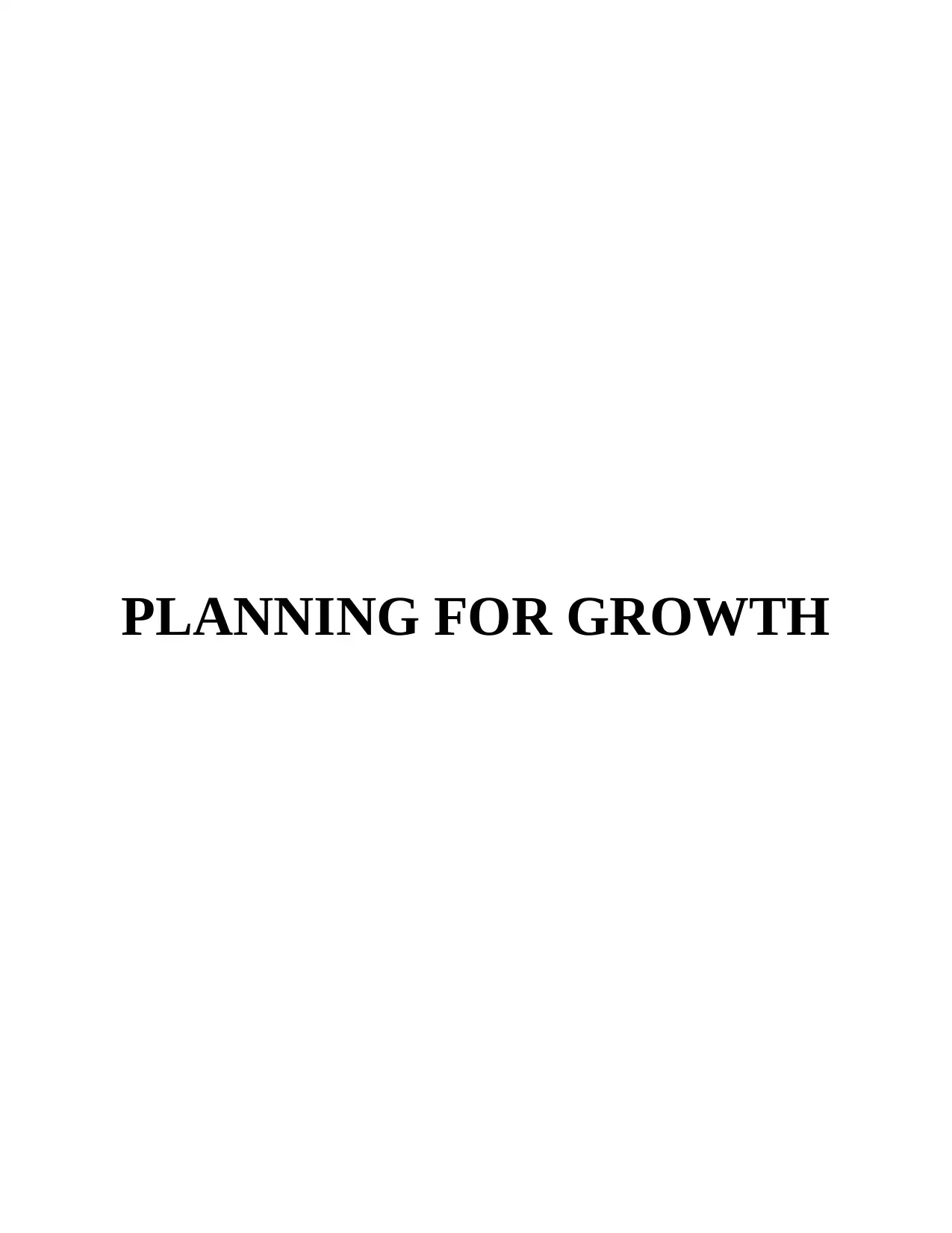
PLANNING FOR GROWTH
Secure Best Marks with AI Grader
Need help grading? Try our AI Grader for instant feedback on your assignments.
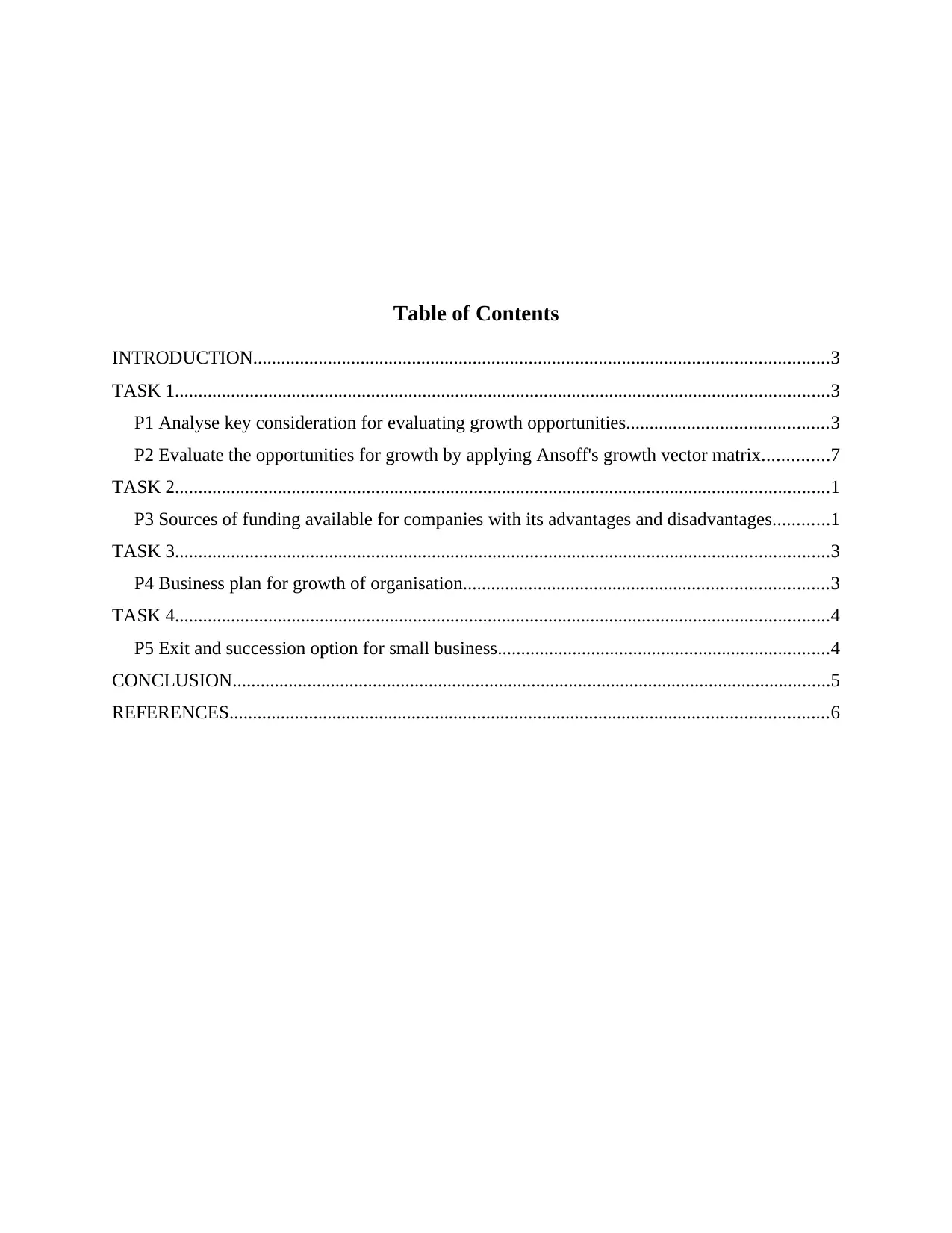
Table of Contents
INTRODUCTION...........................................................................................................................3
TASK 1............................................................................................................................................3
P1 Analyse key consideration for evaluating growth opportunities...........................................3
P2 Evaluate the opportunities for growth by applying Ansoff's growth vector matrix..............7
TASK 2............................................................................................................................................1
P3 Sources of funding available for companies with its advantages and disadvantages............1
TASK 3............................................................................................................................................3
P4 Business plan for growth of organisation..............................................................................3
TASK 4............................................................................................................................................4
P5 Exit and succession option for small business.......................................................................4
CONCLUSION................................................................................................................................5
REFERENCES................................................................................................................................6
INTRODUCTION...........................................................................................................................3
TASK 1............................................................................................................................................3
P1 Analyse key consideration for evaluating growth opportunities...........................................3
P2 Evaluate the opportunities for growth by applying Ansoff's growth vector matrix..............7
TASK 2............................................................................................................................................1
P3 Sources of funding available for companies with its advantages and disadvantages............1
TASK 3............................................................................................................................................3
P4 Business plan for growth of organisation..............................................................................3
TASK 4............................................................................................................................................4
P5 Exit and succession option for small business.......................................................................4
CONCLUSION................................................................................................................................5
REFERENCES................................................................................................................................6
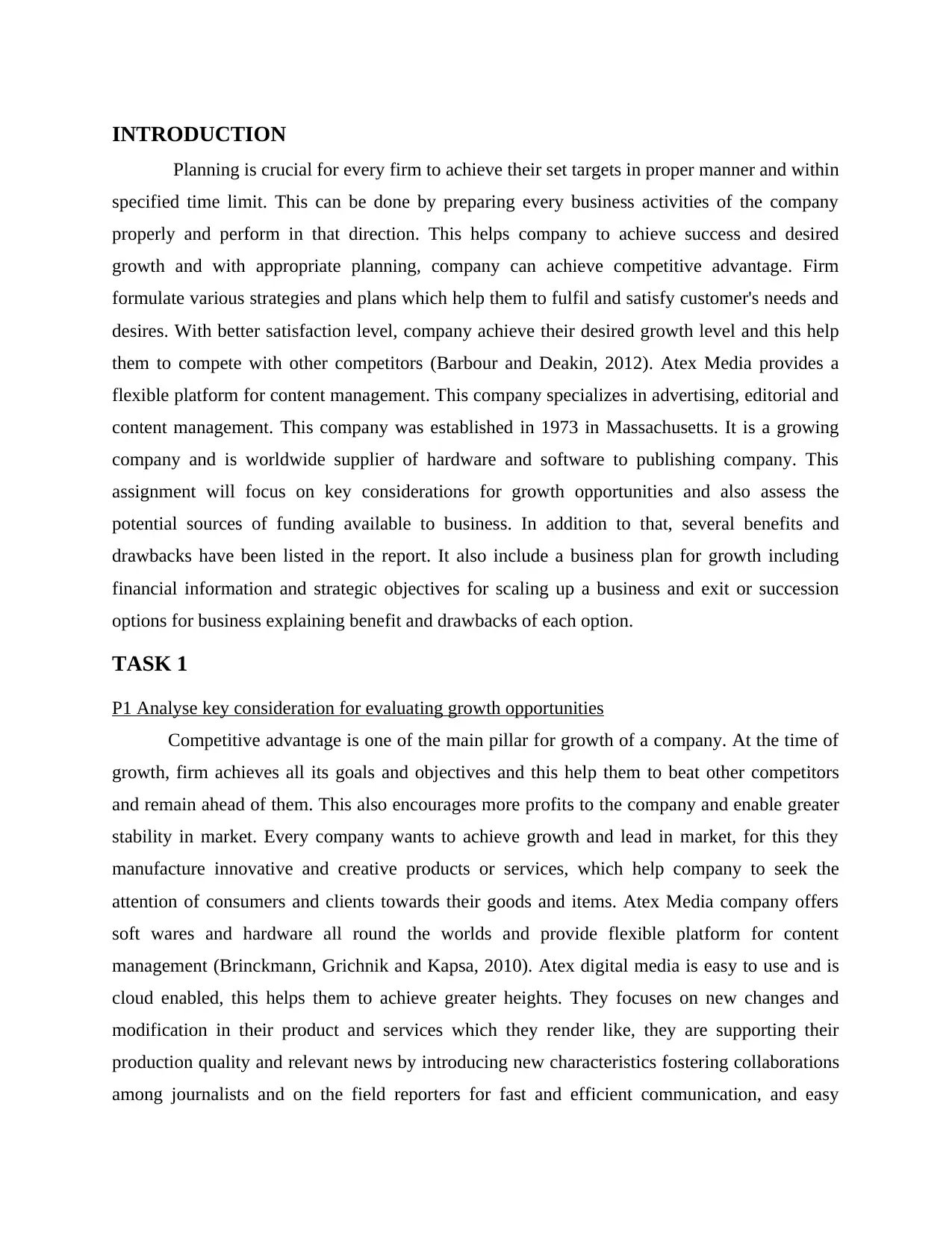
INTRODUCTION
Planning is crucial for every firm to achieve their set targets in proper manner and within
specified time limit. This can be done by preparing every business activities of the company
properly and perform in that direction. This helps company to achieve success and desired
growth and with appropriate planning, company can achieve competitive advantage. Firm
formulate various strategies and plans which help them to fulfil and satisfy customer's needs and
desires. With better satisfaction level, company achieve their desired growth level and this help
them to compete with other competitors (Barbour and Deakin, 2012). Atex Media provides a
flexible platform for content management. This company specializes in advertising, editorial and
content management. This company was established in 1973 in Massachusetts. It is a growing
company and is worldwide supplier of hardware and software to publishing company. This
assignment will focus on key considerations for growth opportunities and also assess the
potential sources of funding available to business. In addition to that, several benefits and
drawbacks have been listed in the report. It also include a business plan for growth including
financial information and strategic objectives for scaling up a business and exit or succession
options for business explaining benefit and drawbacks of each option.
TASK 1
P1 Analyse key consideration for evaluating growth opportunities
Competitive advantage is one of the main pillar for growth of a company. At the time of
growth, firm achieves all its goals and objectives and this help them to beat other competitors
and remain ahead of them. This also encourages more profits to the company and enable greater
stability in market. Every company wants to achieve growth and lead in market, for this they
manufacture innovative and creative products or services, which help company to seek the
attention of consumers and clients towards their goods and items. Atex Media company offers
soft wares and hardware all round the worlds and provide flexible platform for content
management (Brinckmann, Grichnik and Kapsa, 2010). Atex digital media is easy to use and is
cloud enabled, this helps them to achieve greater heights. They focuses on new changes and
modification in their product and services which they render like, they are supporting their
production quality and relevant news by introducing new characteristics fostering collaborations
among journalists and on the field reporters for fast and efficient communication, and easy
Planning is crucial for every firm to achieve their set targets in proper manner and within
specified time limit. This can be done by preparing every business activities of the company
properly and perform in that direction. This helps company to achieve success and desired
growth and with appropriate planning, company can achieve competitive advantage. Firm
formulate various strategies and plans which help them to fulfil and satisfy customer's needs and
desires. With better satisfaction level, company achieve their desired growth level and this help
them to compete with other competitors (Barbour and Deakin, 2012). Atex Media provides a
flexible platform for content management. This company specializes in advertising, editorial and
content management. This company was established in 1973 in Massachusetts. It is a growing
company and is worldwide supplier of hardware and software to publishing company. This
assignment will focus on key considerations for growth opportunities and also assess the
potential sources of funding available to business. In addition to that, several benefits and
drawbacks have been listed in the report. It also include a business plan for growth including
financial information and strategic objectives for scaling up a business and exit or succession
options for business explaining benefit and drawbacks of each option.
TASK 1
P1 Analyse key consideration for evaluating growth opportunities
Competitive advantage is one of the main pillar for growth of a company. At the time of
growth, firm achieves all its goals and objectives and this help them to beat other competitors
and remain ahead of them. This also encourages more profits to the company and enable greater
stability in market. Every company wants to achieve growth and lead in market, for this they
manufacture innovative and creative products or services, which help company to seek the
attention of consumers and clients towards their goods and items. Atex Media company offers
soft wares and hardware all round the worlds and provide flexible platform for content
management (Brinckmann, Grichnik and Kapsa, 2010). Atex digital media is easy to use and is
cloud enabled, this helps them to achieve greater heights. They focuses on new changes and
modification in their product and services which they render like, they are supporting their
production quality and relevant news by introducing new characteristics fostering collaborations
among journalists and on the field reporters for fast and efficient communication, and easy
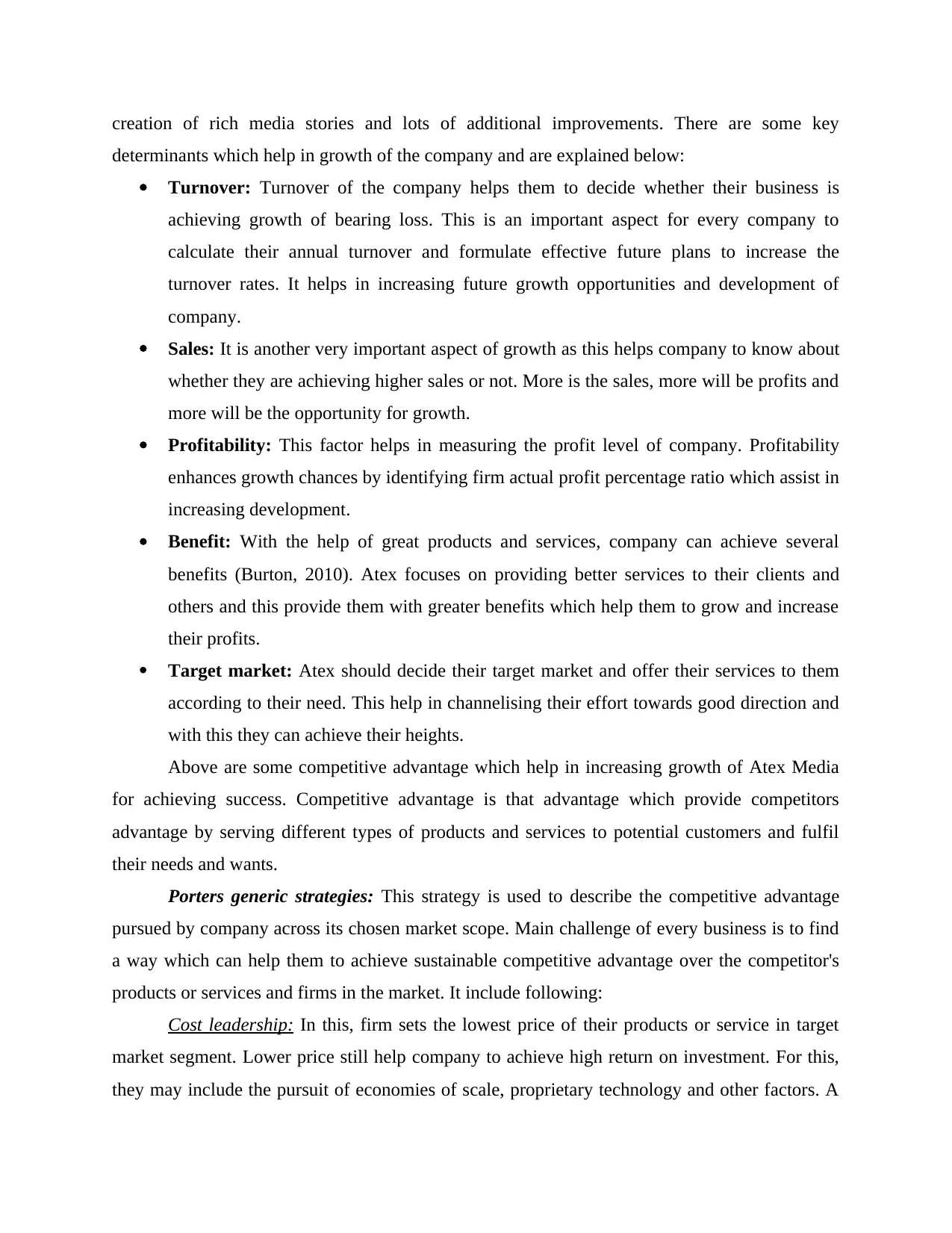
creation of rich media stories and lots of additional improvements. There are some key
determinants which help in growth of the company and are explained below:
Turnover: Turnover of the company helps them to decide whether their business is
achieving growth of bearing loss. This is an important aspect for every company to
calculate their annual turnover and formulate effective future plans to increase the
turnover rates. It helps in increasing future growth opportunities and development of
company.
Sales: It is another very important aspect of growth as this helps company to know about
whether they are achieving higher sales or not. More is the sales, more will be profits and
more will be the opportunity for growth.
Profitability: This factor helps in measuring the profit level of company. Profitability
enhances growth chances by identifying firm actual profit percentage ratio which assist in
increasing development.
Benefit: With the help of great products and services, company can achieve several
benefits (Burton, 2010). Atex focuses on providing better services to their clients and
others and this provide them with greater benefits which help them to grow and increase
their profits.
Target market: Atex should decide their target market and offer their services to them
according to their need. This help in channelising their effort towards good direction and
with this they can achieve their heights.
Above are some competitive advantage which help in increasing growth of Atex Media
for achieving success. Competitive advantage is that advantage which provide competitors
advantage by serving different types of products and services to potential customers and fulfil
their needs and wants.
Porters generic strategies: This strategy is used to describe the competitive advantage
pursued by company across its chosen market scope. Main challenge of every business is to find
a way which can help them to achieve sustainable competitive advantage over the competitor's
products or services and firms in the market. It include following:
Cost leadership: In this, firm sets the lowest price of their products or service in target
market segment. Lower price still help company to achieve high return on investment. For this,
they may include the pursuit of economies of scale, proprietary technology and other factors. A
determinants which help in growth of the company and are explained below:
Turnover: Turnover of the company helps them to decide whether their business is
achieving growth of bearing loss. This is an important aspect for every company to
calculate their annual turnover and formulate effective future plans to increase the
turnover rates. It helps in increasing future growth opportunities and development of
company.
Sales: It is another very important aspect of growth as this helps company to know about
whether they are achieving higher sales or not. More is the sales, more will be profits and
more will be the opportunity for growth.
Profitability: This factor helps in measuring the profit level of company. Profitability
enhances growth chances by identifying firm actual profit percentage ratio which assist in
increasing development.
Benefit: With the help of great products and services, company can achieve several
benefits (Burton, 2010). Atex focuses on providing better services to their clients and
others and this provide them with greater benefits which help them to grow and increase
their profits.
Target market: Atex should decide their target market and offer their services to them
according to their need. This help in channelising their effort towards good direction and
with this they can achieve their heights.
Above are some competitive advantage which help in increasing growth of Atex Media
for achieving success. Competitive advantage is that advantage which provide competitors
advantage by serving different types of products and services to potential customers and fulfil
their needs and wants.
Porters generic strategies: This strategy is used to describe the competitive advantage
pursued by company across its chosen market scope. Main challenge of every business is to find
a way which can help them to achieve sustainable competitive advantage over the competitor's
products or services and firms in the market. It include following:
Cost leadership: In this, firm sets the lowest price of their products or service in target
market segment. Lower price still help company to achieve high return on investment. For this,
they may include the pursuit of economies of scale, proprietary technology and other factors. A
Secure Best Marks with AI Grader
Need help grading? Try our AI Grader for instant feedback on your assignments.
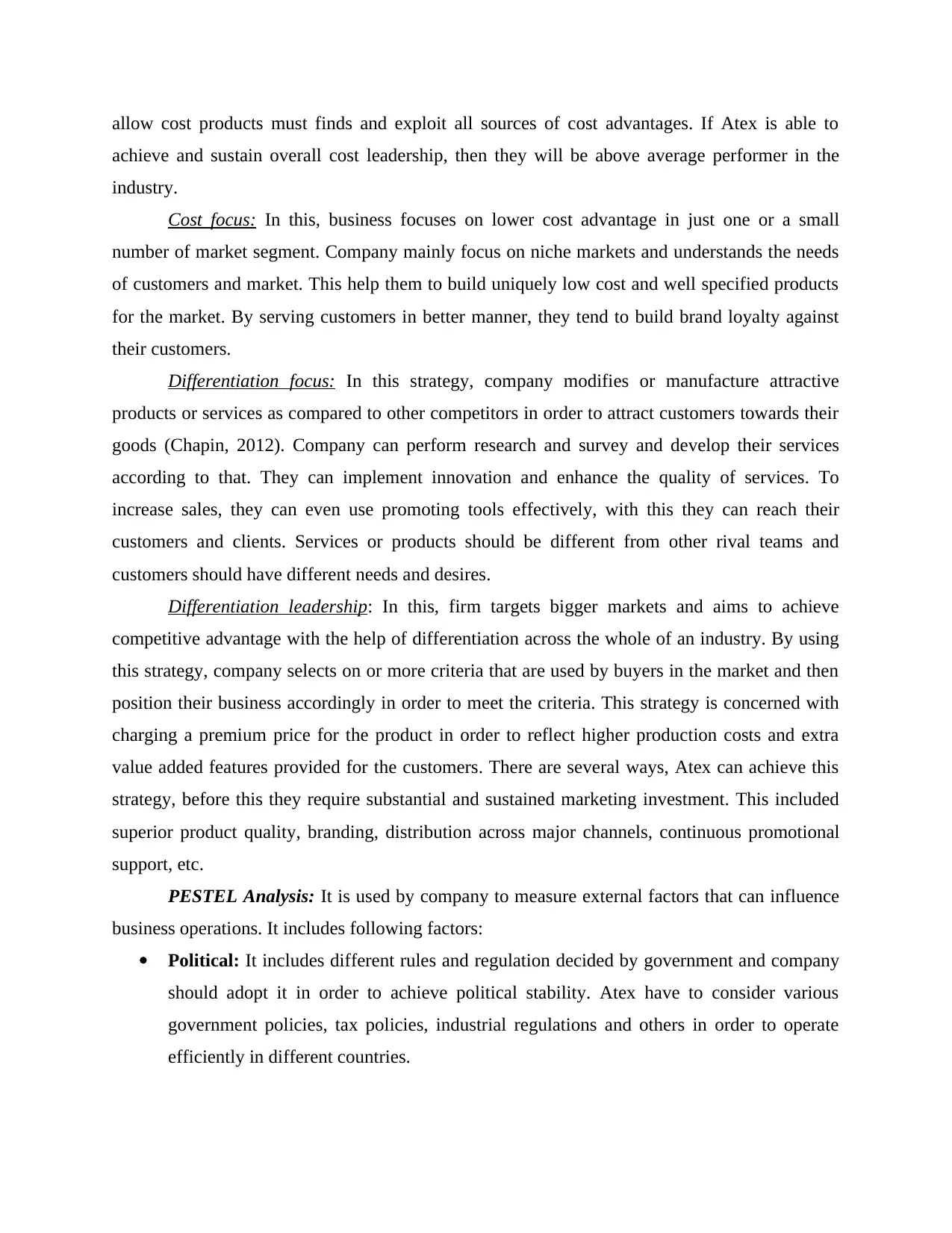
allow cost products must finds and exploit all sources of cost advantages. If Atex is able to
achieve and sustain overall cost leadership, then they will be above average performer in the
industry.
Cost focus: In this, business focuses on lower cost advantage in just one or a small
number of market segment. Company mainly focus on niche markets and understands the needs
of customers and market. This help them to build uniquely low cost and well specified products
for the market. By serving customers in better manner, they tend to build brand loyalty against
their customers.
Differentiation focus: In this strategy, company modifies or manufacture attractive
products or services as compared to other competitors in order to attract customers towards their
goods (Chapin, 2012). Company can perform research and survey and develop their services
according to that. They can implement innovation and enhance the quality of services. To
increase sales, they can even use promoting tools effectively, with this they can reach their
customers and clients. Services or products should be different from other rival teams and
customers should have different needs and desires.
Differentiation leadership: In this, firm targets bigger markets and aims to achieve
competitive advantage with the help of differentiation across the whole of an industry. By using
this strategy, company selects on or more criteria that are used by buyers in the market and then
position their business accordingly in order to meet the criteria. This strategy is concerned with
charging a premium price for the product in order to reflect higher production costs and extra
value added features provided for the customers. There are several ways, Atex can achieve this
strategy, before this they require substantial and sustained marketing investment. This included
superior product quality, branding, distribution across major channels, continuous promotional
support, etc.
PESTEL Analysis: It is used by company to measure external factors that can influence
business operations. It includes following factors:
Political: It includes different rules and regulation decided by government and company
should adopt it in order to achieve political stability. Atex have to consider various
government policies, tax policies, industrial regulations and others in order to operate
efficiently in different countries.
achieve and sustain overall cost leadership, then they will be above average performer in the
industry.
Cost focus: In this, business focuses on lower cost advantage in just one or a small
number of market segment. Company mainly focus on niche markets and understands the needs
of customers and market. This help them to build uniquely low cost and well specified products
for the market. By serving customers in better manner, they tend to build brand loyalty against
their customers.
Differentiation focus: In this strategy, company modifies or manufacture attractive
products or services as compared to other competitors in order to attract customers towards their
goods (Chapin, 2012). Company can perform research and survey and develop their services
according to that. They can implement innovation and enhance the quality of services. To
increase sales, they can even use promoting tools effectively, with this they can reach their
customers and clients. Services or products should be different from other rival teams and
customers should have different needs and desires.
Differentiation leadership: In this, firm targets bigger markets and aims to achieve
competitive advantage with the help of differentiation across the whole of an industry. By using
this strategy, company selects on or more criteria that are used by buyers in the market and then
position their business accordingly in order to meet the criteria. This strategy is concerned with
charging a premium price for the product in order to reflect higher production costs and extra
value added features provided for the customers. There are several ways, Atex can achieve this
strategy, before this they require substantial and sustained marketing investment. This included
superior product quality, branding, distribution across major channels, continuous promotional
support, etc.
PESTEL Analysis: It is used by company to measure external factors that can influence
business operations. It includes following factors:
Political: It includes different rules and regulation decided by government and company
should adopt it in order to achieve political stability. Atex have to consider various
government policies, tax policies, industrial regulations and others in order to operate
efficiently in different countries.
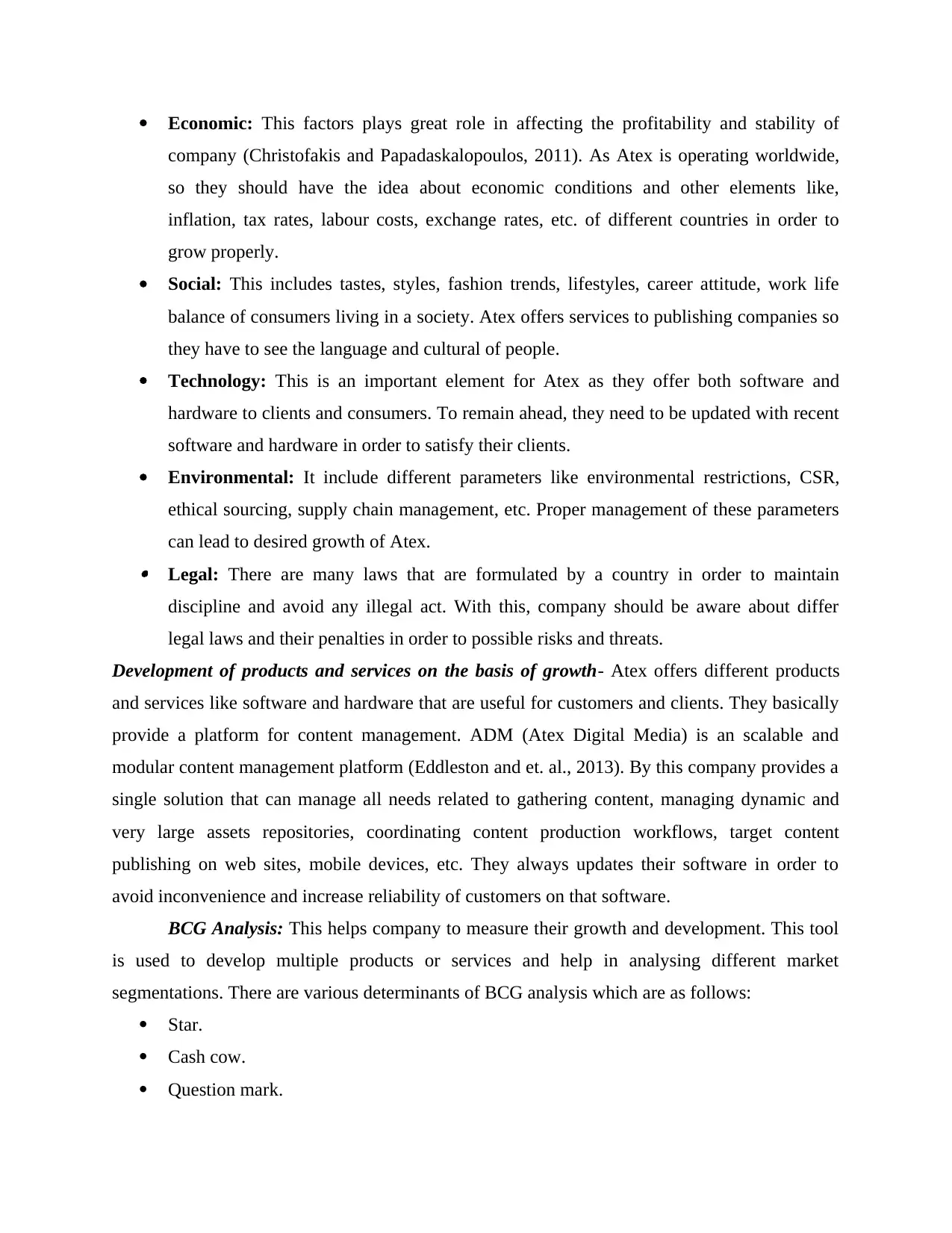
Economic: This factors plays great role in affecting the profitability and stability of
company (Christofakis and Papadaskalopoulos, 2011). As Atex is operating worldwide,
so they should have the idea about economic conditions and other elements like,
inflation, tax rates, labour costs, exchange rates, etc. of different countries in order to
grow properly.
Social: This includes tastes, styles, fashion trends, lifestyles, career attitude, work life
balance of consumers living in a society. Atex offers services to publishing companies so
they have to see the language and cultural of people.
Technology: This is an important element for Atex as they offer both software and
hardware to clients and consumers. To remain ahead, they need to be updated with recent
software and hardware in order to satisfy their clients.
Environmental: It include different parameters like environmental restrictions, CSR,
ethical sourcing, supply chain management, etc. Proper management of these parameters
can lead to desired growth of Atex. Legal: There are many laws that are formulated by a country in order to maintain
discipline and avoid any illegal act. With this, company should be aware about differ
legal laws and their penalties in order to possible risks and threats.
Development of products and services on the basis of growth- Atex offers different products
and services like software and hardware that are useful for customers and clients. They basically
provide a platform for content management. ADM (Atex Digital Media) is an scalable and
modular content management platform (Eddleston and et. al., 2013). By this company provides a
single solution that can manage all needs related to gathering content, managing dynamic and
very large assets repositories, coordinating content production workflows, target content
publishing on web sites, mobile devices, etc. They always updates their software in order to
avoid inconvenience and increase reliability of customers on that software.
BCG Analysis: This helps company to measure their growth and development. This tool
is used to develop multiple products or services and help in analysing different market
segmentations. There are various determinants of BCG analysis which are as follows:
Star.
Cash cow.
Question mark.
company (Christofakis and Papadaskalopoulos, 2011). As Atex is operating worldwide,
so they should have the idea about economic conditions and other elements like,
inflation, tax rates, labour costs, exchange rates, etc. of different countries in order to
grow properly.
Social: This includes tastes, styles, fashion trends, lifestyles, career attitude, work life
balance of consumers living in a society. Atex offers services to publishing companies so
they have to see the language and cultural of people.
Technology: This is an important element for Atex as they offer both software and
hardware to clients and consumers. To remain ahead, they need to be updated with recent
software and hardware in order to satisfy their clients.
Environmental: It include different parameters like environmental restrictions, CSR,
ethical sourcing, supply chain management, etc. Proper management of these parameters
can lead to desired growth of Atex. Legal: There are many laws that are formulated by a country in order to maintain
discipline and avoid any illegal act. With this, company should be aware about differ
legal laws and their penalties in order to possible risks and threats.
Development of products and services on the basis of growth- Atex offers different products
and services like software and hardware that are useful for customers and clients. They basically
provide a platform for content management. ADM (Atex Digital Media) is an scalable and
modular content management platform (Eddleston and et. al., 2013). By this company provides a
single solution that can manage all needs related to gathering content, managing dynamic and
very large assets repositories, coordinating content production workflows, target content
publishing on web sites, mobile devices, etc. They always updates their software in order to
avoid inconvenience and increase reliability of customers on that software.
BCG Analysis: This helps company to measure their growth and development. This tool
is used to develop multiple products or services and help in analysing different market
segmentations. There are various determinants of BCG analysis which are as follows:
Star.
Cash cow.
Question mark.
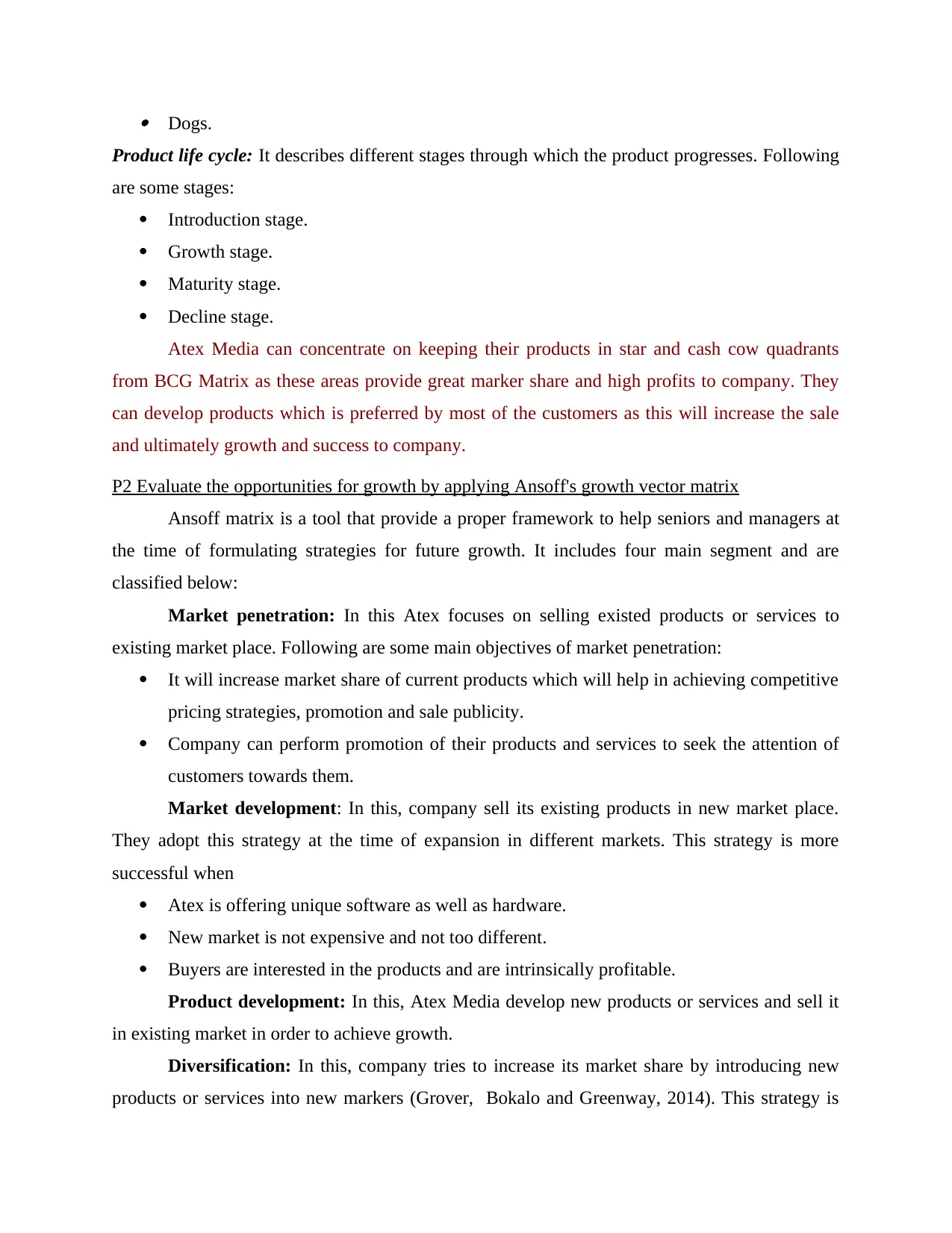
Dogs.
Product life cycle: It describes different stages through which the product progresses. Following
are some stages:
Introduction stage.
Growth stage.
Maturity stage.
Decline stage.
Atex Media can concentrate on keeping their products in star and cash cow quadrants
from BCG Matrix as these areas provide great marker share and high profits to company. They
can develop products which is preferred by most of the customers as this will increase the sale
and ultimately growth and success to company.
P2 Evaluate the opportunities for growth by applying Ansoff's growth vector matrix
Ansoff matrix is a tool that provide a proper framework to help seniors and managers at
the time of formulating strategies for future growth. It includes four main segment and are
classified below:
Market penetration: In this Atex focuses on selling existed products or services to
existing market place. Following are some main objectives of market penetration:
It will increase market share of current products which will help in achieving competitive
pricing strategies, promotion and sale publicity.
Company can perform promotion of their products and services to seek the attention of
customers towards them.
Market development: In this, company sell its existing products in new market place.
They adopt this strategy at the time of expansion in different markets. This strategy is more
successful when
Atex is offering unique software as well as hardware.
New market is not expensive and not too different.
Buyers are interested in the products and are intrinsically profitable.
Product development: In this, Atex Media develop new products or services and sell it
in existing market in order to achieve growth.
Diversification: In this, company tries to increase its market share by introducing new
products or services into new markers (Grover, Bokalo and Greenway, 2014). This strategy is
Product life cycle: It describes different stages through which the product progresses. Following
are some stages:
Introduction stage.
Growth stage.
Maturity stage.
Decline stage.
Atex Media can concentrate on keeping their products in star and cash cow quadrants
from BCG Matrix as these areas provide great marker share and high profits to company. They
can develop products which is preferred by most of the customers as this will increase the sale
and ultimately growth and success to company.
P2 Evaluate the opportunities for growth by applying Ansoff's growth vector matrix
Ansoff matrix is a tool that provide a proper framework to help seniors and managers at
the time of formulating strategies for future growth. It includes four main segment and are
classified below:
Market penetration: In this Atex focuses on selling existed products or services to
existing market place. Following are some main objectives of market penetration:
It will increase market share of current products which will help in achieving competitive
pricing strategies, promotion and sale publicity.
Company can perform promotion of their products and services to seek the attention of
customers towards them.
Market development: In this, company sell its existing products in new market place.
They adopt this strategy at the time of expansion in different markets. This strategy is more
successful when
Atex is offering unique software as well as hardware.
New market is not expensive and not too different.
Buyers are interested in the products and are intrinsically profitable.
Product development: In this, Atex Media develop new products or services and sell it
in existing market in order to achieve growth.
Diversification: In this, company tries to increase its market share by introducing new
products or services into new markers (Grover, Bokalo and Greenway, 2014). This strategy is
Paraphrase This Document
Need a fresh take? Get an instant paraphrase of this document with our AI Paraphraser
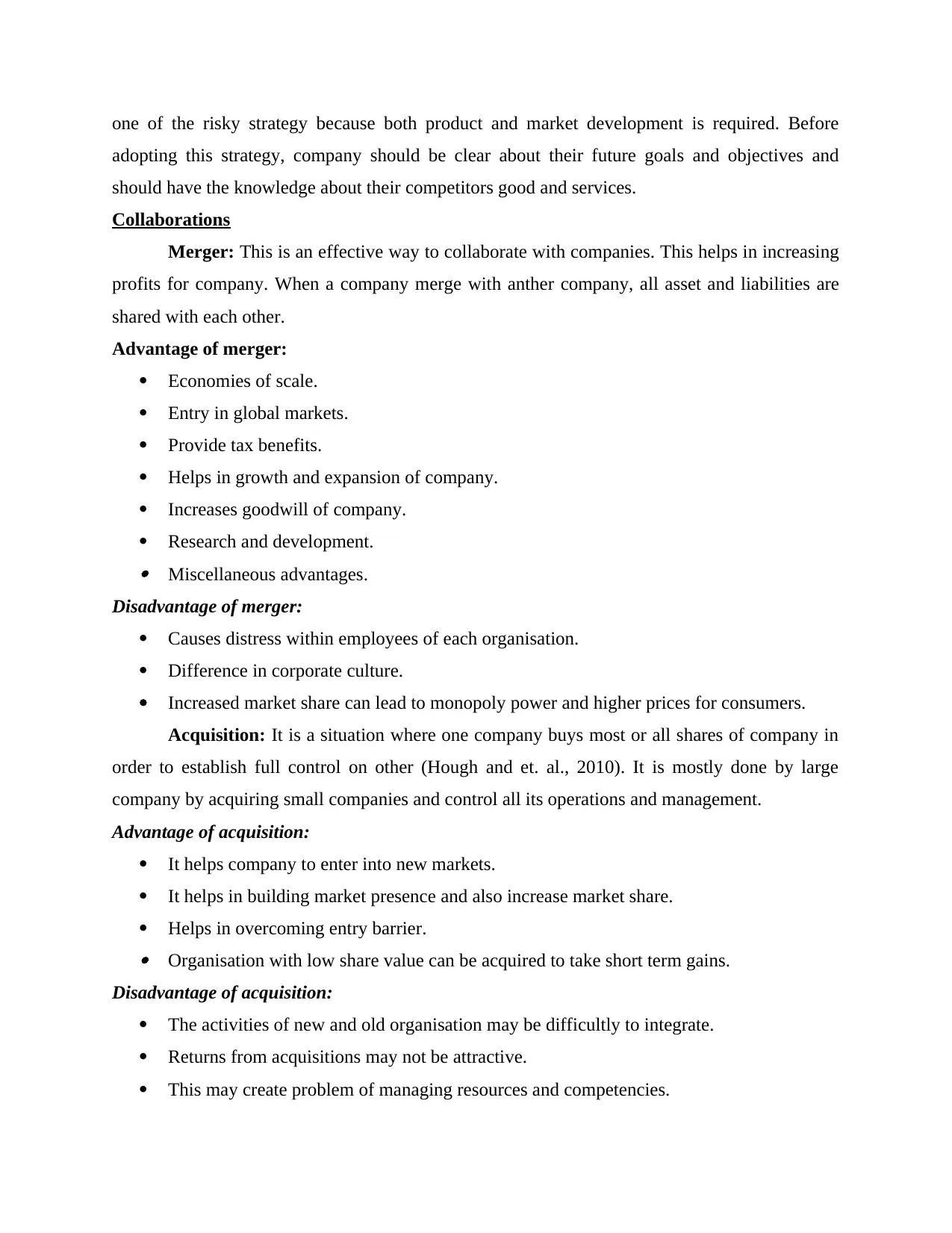
one of the risky strategy because both product and market development is required. Before
adopting this strategy, company should be clear about their future goals and objectives and
should have the knowledge about their competitors good and services.
Collaborations
Merger: This is an effective way to collaborate with companies. This helps in increasing
profits for company. When a company merge with anther company, all asset and liabilities are
shared with each other.
Advantage of merger:
Economies of scale.
Entry in global markets.
Provide tax benefits.
Helps in growth and expansion of company.
Increases goodwill of company.
Research and development. Miscellaneous advantages.
Disadvantage of merger:
Causes distress within employees of each organisation.
Difference in corporate culture.
Increased market share can lead to monopoly power and higher prices for consumers.
Acquisition: It is a situation where one company buys most or all shares of company in
order to establish full control on other (Hough and et. al., 2010). It is mostly done by large
company by acquiring small companies and control all its operations and management.
Advantage of acquisition:
It helps company to enter into new markets.
It helps in building market presence and also increase market share.
Helps in overcoming entry barrier. Organisation with low share value can be acquired to take short term gains.
Disadvantage of acquisition:
The activities of new and old organisation may be difficultly to integrate.
Returns from acquisitions may not be attractive.
This may create problem of managing resources and competencies.
adopting this strategy, company should be clear about their future goals and objectives and
should have the knowledge about their competitors good and services.
Collaborations
Merger: This is an effective way to collaborate with companies. This helps in increasing
profits for company. When a company merge with anther company, all asset and liabilities are
shared with each other.
Advantage of merger:
Economies of scale.
Entry in global markets.
Provide tax benefits.
Helps in growth and expansion of company.
Increases goodwill of company.
Research and development. Miscellaneous advantages.
Disadvantage of merger:
Causes distress within employees of each organisation.
Difference in corporate culture.
Increased market share can lead to monopoly power and higher prices for consumers.
Acquisition: It is a situation where one company buys most or all shares of company in
order to establish full control on other (Hough and et. al., 2010). It is mostly done by large
company by acquiring small companies and control all its operations and management.
Advantage of acquisition:
It helps company to enter into new markets.
It helps in building market presence and also increase market share.
Helps in overcoming entry barrier. Organisation with low share value can be acquired to take short term gains.
Disadvantage of acquisition:
The activities of new and old organisation may be difficultly to integrate.
Returns from acquisitions may not be attractive.
This may create problem of managing resources and competencies.
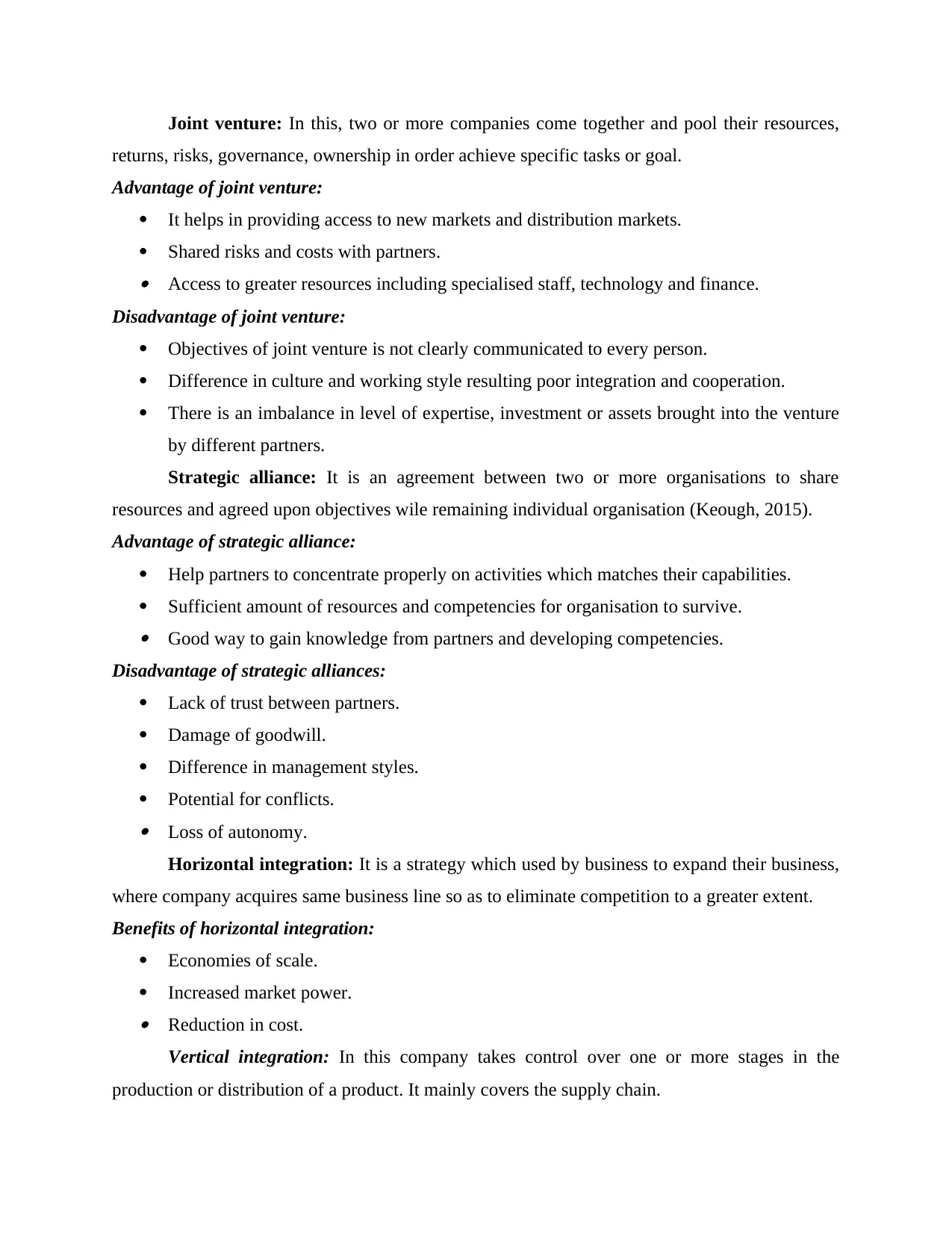
Joint venture: In this, two or more companies come together and pool their resources,
returns, risks, governance, ownership in order achieve specific tasks or goal.
Advantage of joint venture:
It helps in providing access to new markets and distribution markets.
Shared risks and costs with partners. Access to greater resources including specialised staff, technology and finance.
Disadvantage of joint venture:
Objectives of joint venture is not clearly communicated to every person.
Difference in culture and working style resulting poor integration and cooperation.
There is an imbalance in level of expertise, investment or assets brought into the venture
by different partners.
Strategic alliance: It is an agreement between two or more organisations to share
resources and agreed upon objectives wile remaining individual organisation (Keough, 2015).
Advantage of strategic alliance:
Help partners to concentrate properly on activities which matches their capabilities.
Sufficient amount of resources and competencies for organisation to survive. Good way to gain knowledge from partners and developing competencies.
Disadvantage of strategic alliances:
Lack of trust between partners.
Damage of goodwill.
Difference in management styles.
Potential for conflicts. Loss of autonomy.
Horizontal integration: It is a strategy which used by business to expand their business,
where company acquires same business line so as to eliminate competition to a greater extent.
Benefits of horizontal integration:
Economies of scale.
Increased market power. Reduction in cost.
Vertical integration: In this company takes control over one or more stages in the
production or distribution of a product. It mainly covers the supply chain.
returns, risks, governance, ownership in order achieve specific tasks or goal.
Advantage of joint venture:
It helps in providing access to new markets and distribution markets.
Shared risks and costs with partners. Access to greater resources including specialised staff, technology and finance.
Disadvantage of joint venture:
Objectives of joint venture is not clearly communicated to every person.
Difference in culture and working style resulting poor integration and cooperation.
There is an imbalance in level of expertise, investment or assets brought into the venture
by different partners.
Strategic alliance: It is an agreement between two or more organisations to share
resources and agreed upon objectives wile remaining individual organisation (Keough, 2015).
Advantage of strategic alliance:
Help partners to concentrate properly on activities which matches their capabilities.
Sufficient amount of resources and competencies for organisation to survive. Good way to gain knowledge from partners and developing competencies.
Disadvantage of strategic alliances:
Lack of trust between partners.
Damage of goodwill.
Difference in management styles.
Potential for conflicts. Loss of autonomy.
Horizontal integration: It is a strategy which used by business to expand their business,
where company acquires same business line so as to eliminate competition to a greater extent.
Benefits of horizontal integration:
Economies of scale.
Increased market power. Reduction in cost.
Vertical integration: In this company takes control over one or more stages in the
production or distribution of a product. It mainly covers the supply chain.
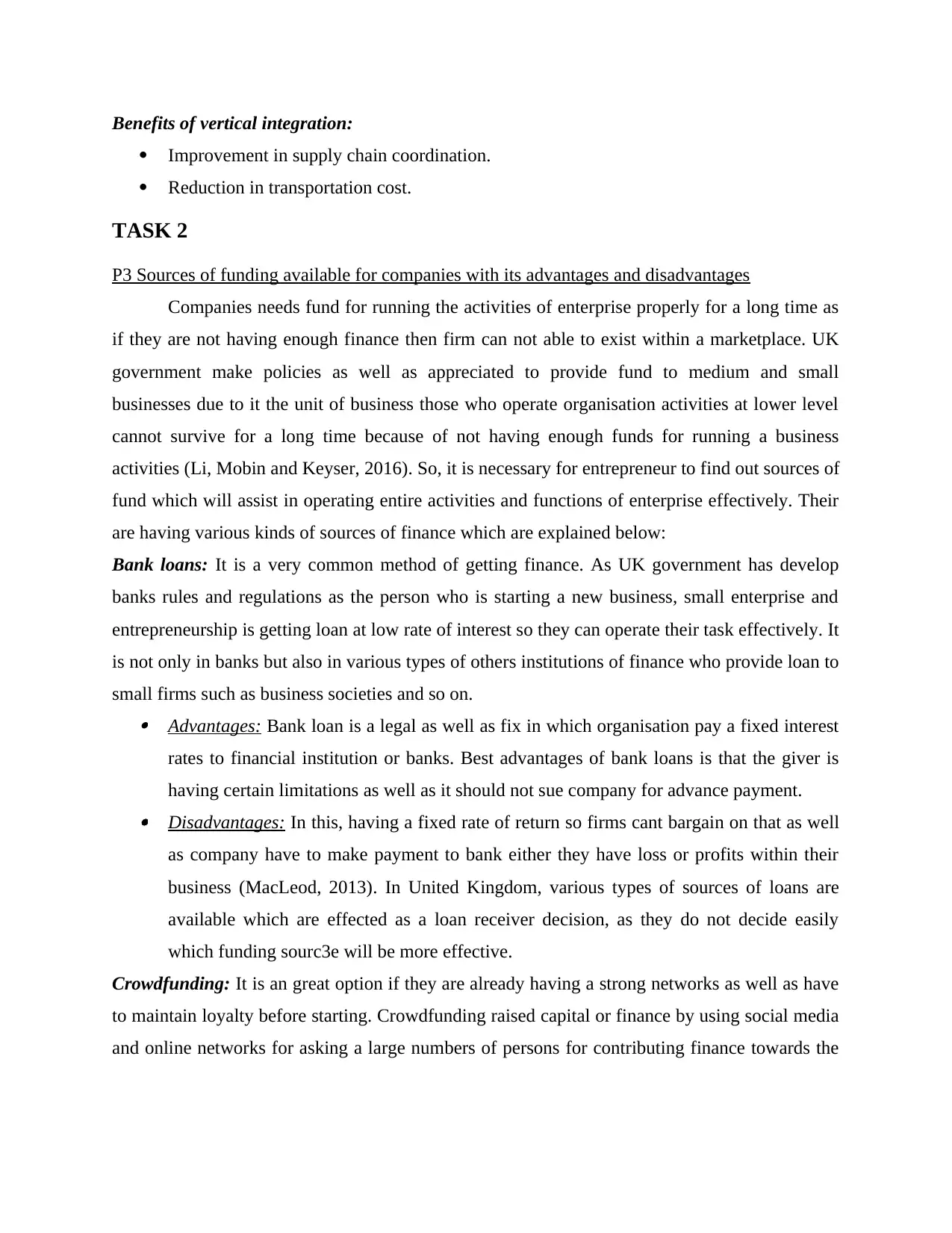
Benefits of vertical integration:
Improvement in supply chain coordination.
Reduction in transportation cost.
TASK 2
P3 Sources of funding available for companies with its advantages and disadvantages
Companies needs fund for running the activities of enterprise properly for a long time as
if they are not having enough finance then firm can not able to exist within a marketplace. UK
government make policies as well as appreciated to provide fund to medium and small
businesses due to it the unit of business those who operate organisation activities at lower level
cannot survive for a long time because of not having enough funds for running a business
activities (Li, Mobin and Keyser, 2016). So, it is necessary for entrepreneur to find out sources of
fund which will assist in operating entire activities and functions of enterprise effectively. Their
are having various kinds of sources of finance which are explained below:
Bank loans: It is a very common method of getting finance. As UK government has develop
banks rules and regulations as the person who is starting a new business, small enterprise and
entrepreneurship is getting loan at low rate of interest so they can operate their task effectively. It
is not only in banks but also in various types of others institutions of finance who provide loan to
small firms such as business societies and so on. Advantages: Bank loan is a legal as well as fix in which organisation pay a fixed interest
rates to financial institution or banks. Best advantages of bank loans is that the giver is
having certain limitations as well as it should not sue company for advance payment. Disadvantages: In this, having a fixed rate of return so firms cant bargain on that as well
as company have to make payment to bank either they have loss or profits within their
business (MacLeod, 2013). In United Kingdom, various types of sources of loans are
available which are effected as a loan receiver decision, as they do not decide easily
which funding sourc3e will be more effective.
Crowdfunding: It is an great option if they are already having a strong networks as well as have
to maintain loyalty before starting. Crowdfunding raised capital or finance by using social media
and online networks for asking a large numbers of persons for contributing finance towards the
Improvement in supply chain coordination.
Reduction in transportation cost.
TASK 2
P3 Sources of funding available for companies with its advantages and disadvantages
Companies needs fund for running the activities of enterprise properly for a long time as
if they are not having enough finance then firm can not able to exist within a marketplace. UK
government make policies as well as appreciated to provide fund to medium and small
businesses due to it the unit of business those who operate organisation activities at lower level
cannot survive for a long time because of not having enough funds for running a business
activities (Li, Mobin and Keyser, 2016). So, it is necessary for entrepreneur to find out sources of
fund which will assist in operating entire activities and functions of enterprise effectively. Their
are having various kinds of sources of finance which are explained below:
Bank loans: It is a very common method of getting finance. As UK government has develop
banks rules and regulations as the person who is starting a new business, small enterprise and
entrepreneurship is getting loan at low rate of interest so they can operate their task effectively. It
is not only in banks but also in various types of others institutions of finance who provide loan to
small firms such as business societies and so on. Advantages: Bank loan is a legal as well as fix in which organisation pay a fixed interest
rates to financial institution or banks. Best advantages of bank loans is that the giver is
having certain limitations as well as it should not sue company for advance payment. Disadvantages: In this, having a fixed rate of return so firms cant bargain on that as well
as company have to make payment to bank either they have loss or profits within their
business (MacLeod, 2013). In United Kingdom, various types of sources of loans are
available which are effected as a loan receiver decision, as they do not decide easily
which funding sourc3e will be more effective.
Crowdfunding: It is an great option if they are already having a strong networks as well as have
to maintain loyalty before starting. Crowdfunding raised capital or finance by using social media
and online networks for asking a large numbers of persons for contributing finance towards the
Secure Best Marks with AI Grader
Need help grading? Try our AI Grader for instant feedback on your assignments.
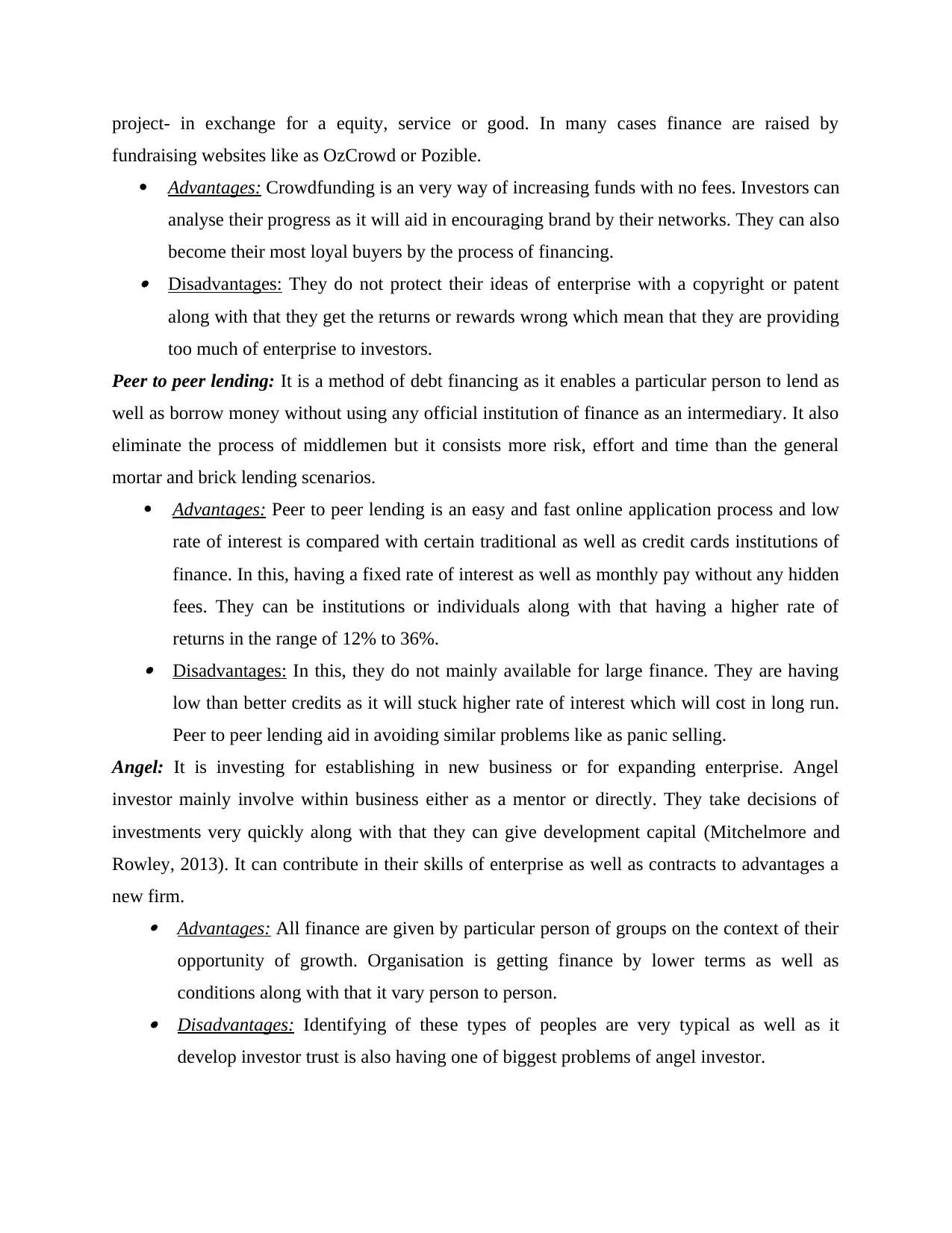
project- in exchange for a equity, service or good. In many cases finance are raised by
fundraising websites like as OzCrowd or Pozible.
Advantages: Crowdfunding is an very way of increasing funds with no fees. Investors can
analyse their progress as it will aid in encouraging brand by their networks. They can also
become their most loyal buyers by the process of financing. Disadvantages: They do not protect their ideas of enterprise with a copyright or patent
along with that they get the returns or rewards wrong which mean that they are providing
too much of enterprise to investors.
Peer to peer lending: It is a method of debt financing as it enables a particular person to lend as
well as borrow money without using any official institution of finance as an intermediary. It also
eliminate the process of middlemen but it consists more risk, effort and time than the general
mortar and brick lending scenarios.
Advantages: Peer to peer lending is an easy and fast online application process and low
rate of interest is compared with certain traditional as well as credit cards institutions of
finance. In this, having a fixed rate of interest as well as monthly pay without any hidden
fees. They can be institutions or individuals along with that having a higher rate of
returns in the range of 12% to 36%. Disadvantages: In this, they do not mainly available for large finance. They are having
low than better credits as it will stuck higher rate of interest which will cost in long run.
Peer to peer lending aid in avoiding similar problems like as panic selling.
Angel: It is investing for establishing in new business or for expanding enterprise. Angel
investor mainly involve within business either as a mentor or directly. They take decisions of
investments very quickly along with that they can give development capital (Mitchelmore and
Rowley, 2013). It can contribute in their skills of enterprise as well as contracts to advantages a
new firm. Advantages: All finance are given by particular person of groups on the context of their
opportunity of growth. Organisation is getting finance by lower terms as well as
conditions along with that it vary person to person. Disadvantages: Identifying of these types of peoples are very typical as well as it
develop investor trust is also having one of biggest problems of angel investor.
fundraising websites like as OzCrowd or Pozible.
Advantages: Crowdfunding is an very way of increasing funds with no fees. Investors can
analyse their progress as it will aid in encouraging brand by their networks. They can also
become their most loyal buyers by the process of financing. Disadvantages: They do not protect their ideas of enterprise with a copyright or patent
along with that they get the returns or rewards wrong which mean that they are providing
too much of enterprise to investors.
Peer to peer lending: It is a method of debt financing as it enables a particular person to lend as
well as borrow money without using any official institution of finance as an intermediary. It also
eliminate the process of middlemen but it consists more risk, effort and time than the general
mortar and brick lending scenarios.
Advantages: Peer to peer lending is an easy and fast online application process and low
rate of interest is compared with certain traditional as well as credit cards institutions of
finance. In this, having a fixed rate of interest as well as monthly pay without any hidden
fees. They can be institutions or individuals along with that having a higher rate of
returns in the range of 12% to 36%. Disadvantages: In this, they do not mainly available for large finance. They are having
low than better credits as it will stuck higher rate of interest which will cost in long run.
Peer to peer lending aid in avoiding similar problems like as panic selling.
Angel: It is investing for establishing in new business or for expanding enterprise. Angel
investor mainly involve within business either as a mentor or directly. They take decisions of
investments very quickly along with that they can give development capital (Mitchelmore and
Rowley, 2013). It can contribute in their skills of enterprise as well as contracts to advantages a
new firm. Advantages: All finance are given by particular person of groups on the context of their
opportunity of growth. Organisation is getting finance by lower terms as well as
conditions along with that it vary person to person. Disadvantages: Identifying of these types of peoples are very typical as well as it
develop investor trust is also having one of biggest problems of angel investor.
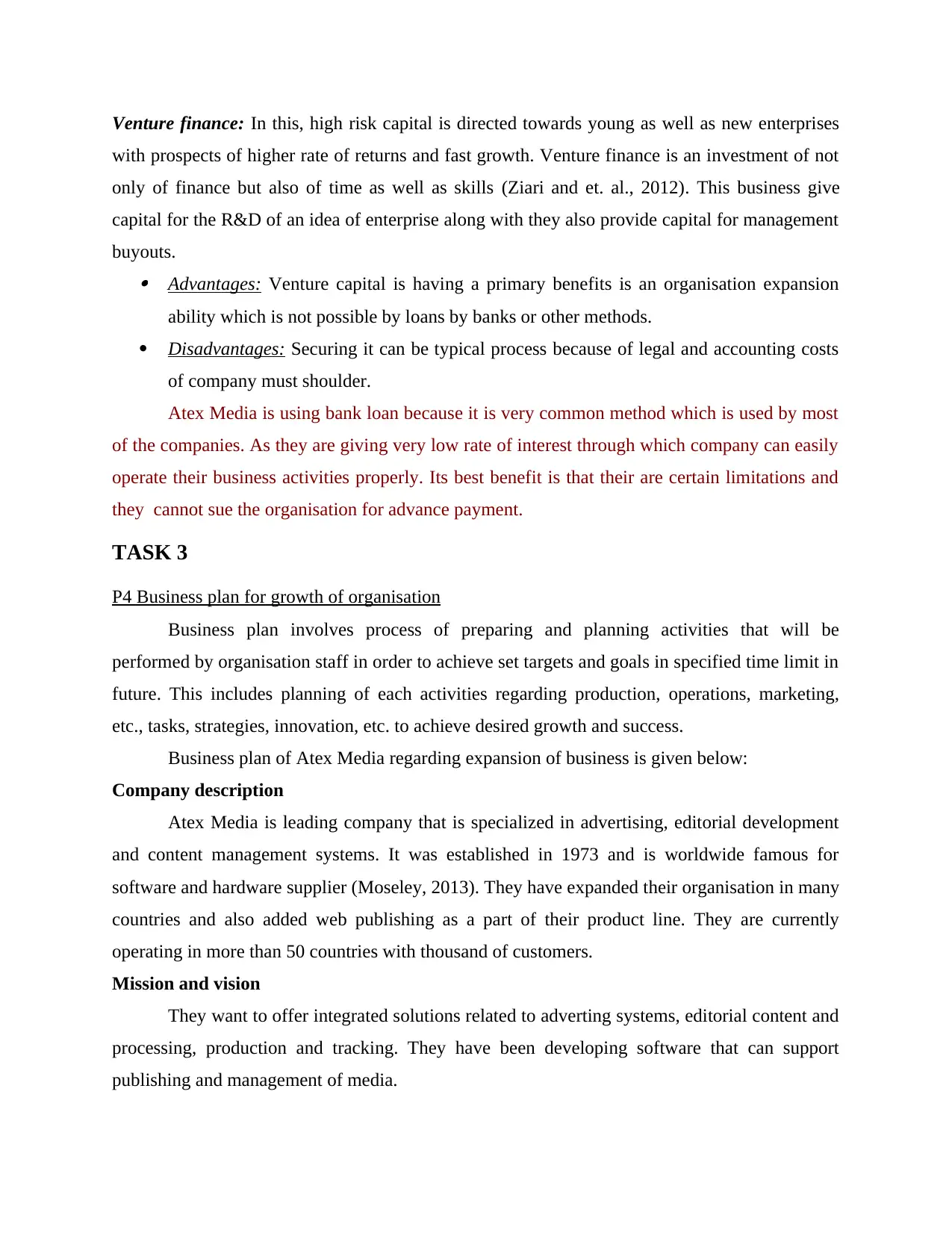
Venture finance: In this, high risk capital is directed towards young as well as new enterprises
with prospects of higher rate of returns and fast growth. Venture finance is an investment of not
only of finance but also of time as well as skills (Ziari and et. al., 2012). This business give
capital for the R&D of an idea of enterprise along with they also provide capital for management
buyouts. Advantages: Venture capital is having a primary benefits is an organisation expansion
ability which is not possible by loans by banks or other methods.
Disadvantages: Securing it can be typical process because of legal and accounting costs
of company must shoulder.
Atex Media is using bank loan because it is very common method which is used by most
of the companies. As they are giving very low rate of interest through which company can easily
operate their business activities properly. Its best benefit is that their are certain limitations and
they cannot sue the organisation for advance payment.
TASK 3
P4 Business plan for growth of organisation
Business plan involves process of preparing and planning activities that will be
performed by organisation staff in order to achieve set targets and goals in specified time limit in
future. This includes planning of each activities regarding production, operations, marketing,
etc., tasks, strategies, innovation, etc. to achieve desired growth and success.
Business plan of Atex Media regarding expansion of business is given below:
Company description
Atex Media is leading company that is specialized in advertising, editorial development
and content management systems. It was established in 1973 and is worldwide famous for
software and hardware supplier (Moseley, 2013). They have expanded their organisation in many
countries and also added web publishing as a part of their product line. They are currently
operating in more than 50 countries with thousand of customers.
Mission and vision
They want to offer integrated solutions related to adverting systems, editorial content and
processing, production and tracking. They have been developing software that can support
publishing and management of media.
with prospects of higher rate of returns and fast growth. Venture finance is an investment of not
only of finance but also of time as well as skills (Ziari and et. al., 2012). This business give
capital for the R&D of an idea of enterprise along with they also provide capital for management
buyouts. Advantages: Venture capital is having a primary benefits is an organisation expansion
ability which is not possible by loans by banks or other methods.
Disadvantages: Securing it can be typical process because of legal and accounting costs
of company must shoulder.
Atex Media is using bank loan because it is very common method which is used by most
of the companies. As they are giving very low rate of interest through which company can easily
operate their business activities properly. Its best benefit is that their are certain limitations and
they cannot sue the organisation for advance payment.
TASK 3
P4 Business plan for growth of organisation
Business plan involves process of preparing and planning activities that will be
performed by organisation staff in order to achieve set targets and goals in specified time limit in
future. This includes planning of each activities regarding production, operations, marketing,
etc., tasks, strategies, innovation, etc. to achieve desired growth and success.
Business plan of Atex Media regarding expansion of business is given below:
Company description
Atex Media is leading company that is specialized in advertising, editorial development
and content management systems. It was established in 1973 and is worldwide famous for
software and hardware supplier (Moseley, 2013). They have expanded their organisation in many
countries and also added web publishing as a part of their product line. They are currently
operating in more than 50 countries with thousand of customers.
Mission and vision
They want to offer integrated solutions related to adverting systems, editorial content and
processing, production and tracking. They have been developing software that can support
publishing and management of media.
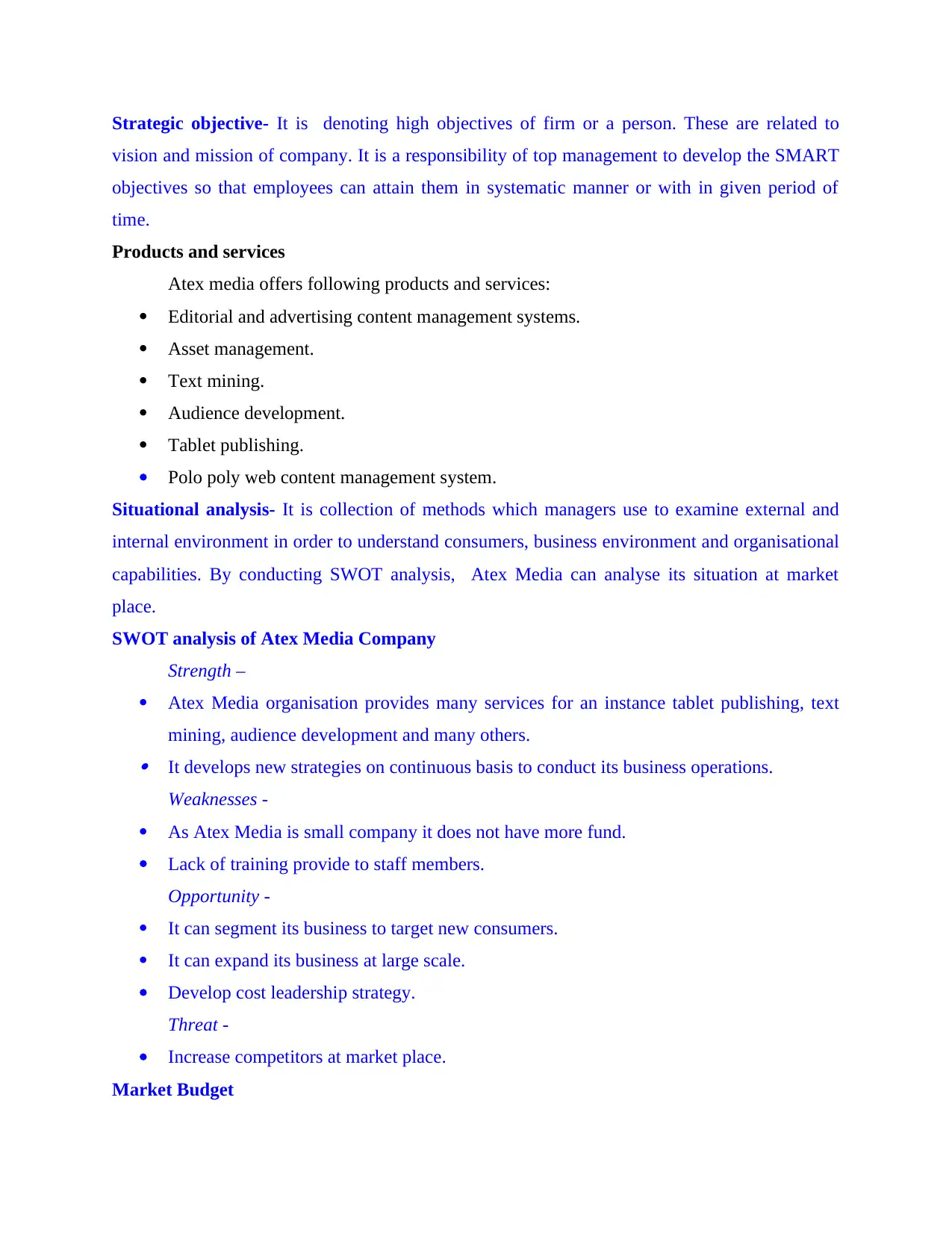
Strategic objective- It is denoting high objectives of firm or a person. These are related to
vision and mission of company. It is a responsibility of top management to develop the SMART
objectives so that employees can attain them in systematic manner or with in given period of
time.
Products and services
Atex media offers following products and services:
Editorial and advertising content management systems.
Asset management.
Text mining.
Audience development.
Tablet publishing.
Polo poly web content management system.
Situational analysis- It is collection of methods which managers use to examine external and
internal environment in order to understand consumers, business environment and organisational
capabilities. By conducting SWOT analysis, Atex Media can analyse its situation at market
place.
SWOT analysis of Atex Media Company
Strength –
Atex Media organisation provides many services for an instance tablet publishing, text
mining, audience development and many others. It develops new strategies on continuous basis to conduct its business operations.
Weaknesses -
As Atex Media is small company it does not have more fund.
Lack of training provide to staff members.
Opportunity -
It can segment its business to target new consumers.
It can expand its business at large scale.
Develop cost leadership strategy.
Threat -
Increase competitors at market place.
Market Budget
vision and mission of company. It is a responsibility of top management to develop the SMART
objectives so that employees can attain them in systematic manner or with in given period of
time.
Products and services
Atex media offers following products and services:
Editorial and advertising content management systems.
Asset management.
Text mining.
Audience development.
Tablet publishing.
Polo poly web content management system.
Situational analysis- It is collection of methods which managers use to examine external and
internal environment in order to understand consumers, business environment and organisational
capabilities. By conducting SWOT analysis, Atex Media can analyse its situation at market
place.
SWOT analysis of Atex Media Company
Strength –
Atex Media organisation provides many services for an instance tablet publishing, text
mining, audience development and many others. It develops new strategies on continuous basis to conduct its business operations.
Weaknesses -
As Atex Media is small company it does not have more fund.
Lack of training provide to staff members.
Opportunity -
It can segment its business to target new consumers.
It can expand its business at large scale.
Develop cost leadership strategy.
Threat -
Increase competitors at market place.
Market Budget
Paraphrase This Document
Need a fresh take? Get an instant paraphrase of this document with our AI Paraphraser
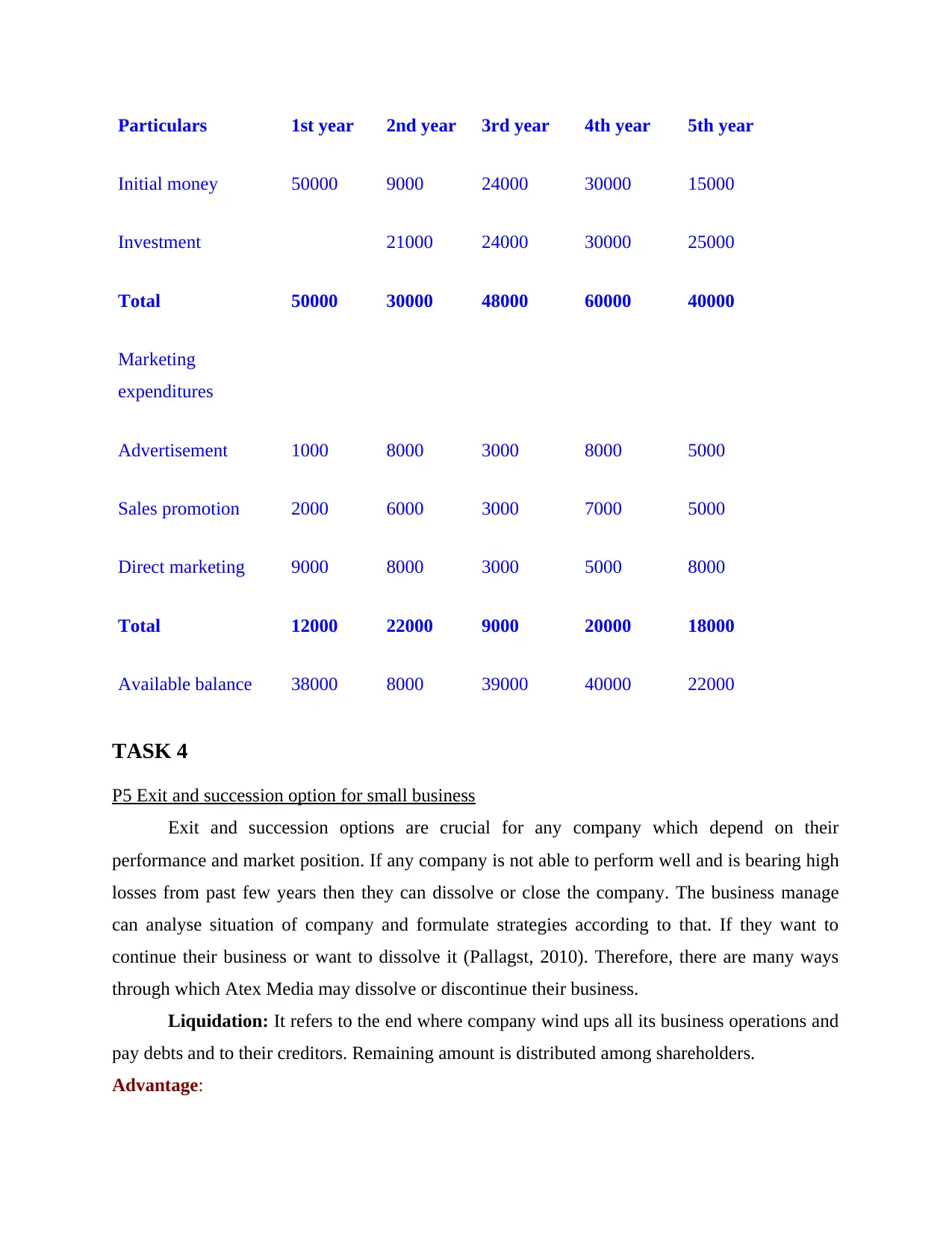
Particulars 1st year 2nd year 3rd year 4th year 5th year
Initial money 50000 9000 24000 30000 15000
Investment 21000 24000 30000 25000
Total 50000 30000 48000 60000 40000
Marketing
expenditures
Advertisement 1000 8000 3000 8000 5000
Sales promotion 2000 6000 3000 7000 5000
Direct marketing 9000 8000 3000 5000 8000
Total 12000 22000 9000 20000 18000
Available balance 38000 8000 39000 40000 22000
TASK 4
P5 Exit and succession option for small business
Exit and succession options are crucial for any company which depend on their
performance and market position. If any company is not able to perform well and is bearing high
losses from past few years then they can dissolve or close the company. The business manage
can analyse situation of company and formulate strategies according to that. If they want to
continue their business or want to dissolve it (Pallagst, 2010). Therefore, there are many ways
through which Atex Media may dissolve or discontinue their business.
Liquidation: It refers to the end where company wind ups all its business operations and
pay debts and to their creditors. Remaining amount is distributed among shareholders.
Advantage:
Initial money 50000 9000 24000 30000 15000
Investment 21000 24000 30000 25000
Total 50000 30000 48000 60000 40000
Marketing
expenditures
Advertisement 1000 8000 3000 8000 5000
Sales promotion 2000 6000 3000 7000 5000
Direct marketing 9000 8000 3000 5000 8000
Total 12000 22000 9000 20000 18000
Available balance 38000 8000 39000 40000 22000
TASK 4
P5 Exit and succession option for small business
Exit and succession options are crucial for any company which depend on their
performance and market position. If any company is not able to perform well and is bearing high
losses from past few years then they can dissolve or close the company. The business manage
can analyse situation of company and formulate strategies according to that. If they want to
continue their business or want to dissolve it (Pallagst, 2010). Therefore, there are many ways
through which Atex Media may dissolve or discontinue their business.
Liquidation: It refers to the end where company wind ups all its business operations and
pay debts and to their creditors. Remaining amount is distributed among shareholders.
Advantage:
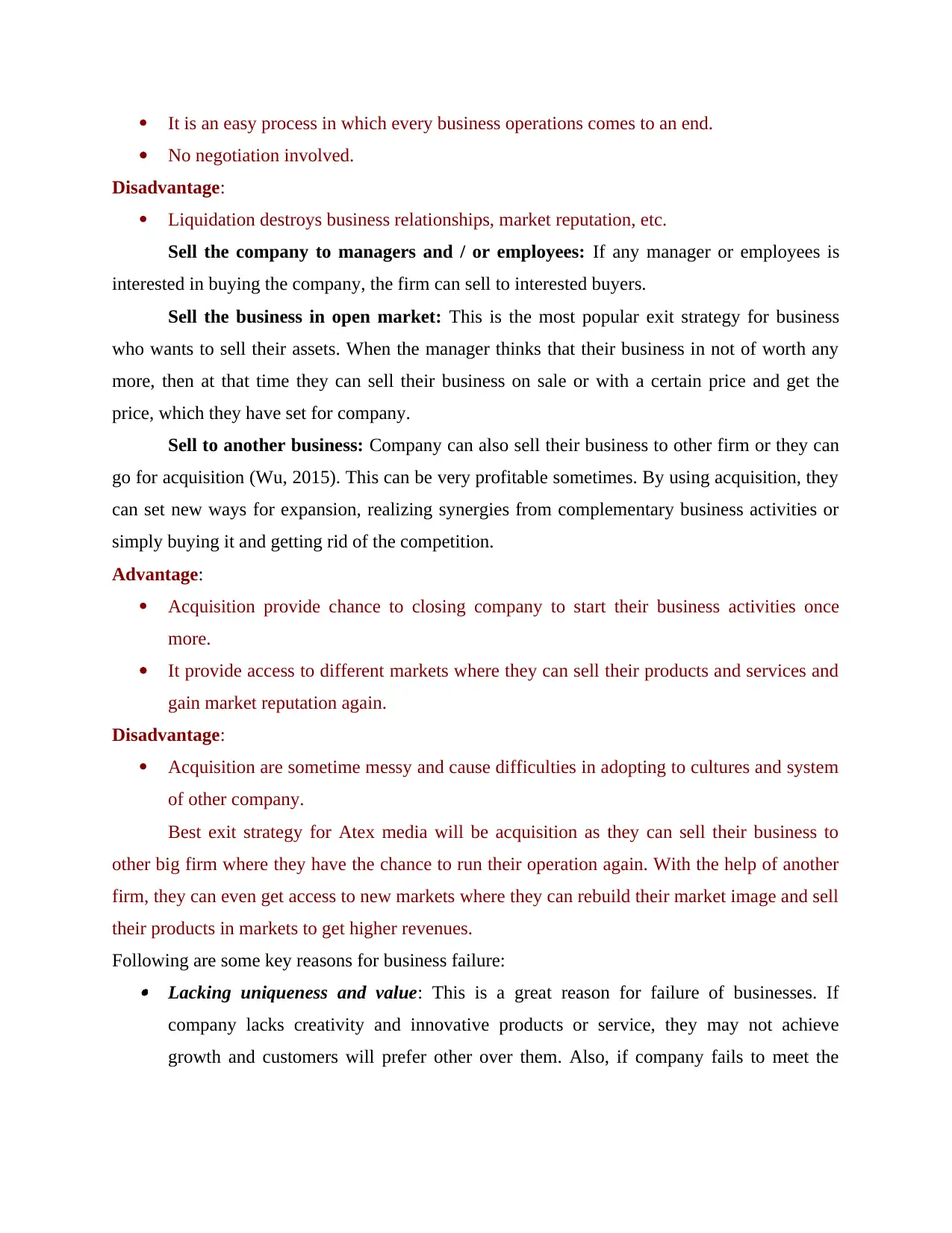
It is an easy process in which every business operations comes to an end.
No negotiation involved.
Disadvantage:
Liquidation destroys business relationships, market reputation, etc.
Sell the company to managers and / or employees: If any manager or employees is
interested in buying the company, the firm can sell to interested buyers.
Sell the business in open market: This is the most popular exit strategy for business
who wants to sell their assets. When the manager thinks that their business in not of worth any
more, then at that time they can sell their business on sale or with a certain price and get the
price, which they have set for company.
Sell to another business: Company can also sell their business to other firm or they can
go for acquisition (Wu, 2015). This can be very profitable sometimes. By using acquisition, they
can set new ways for expansion, realizing synergies from complementary business activities or
simply buying it and getting rid of the competition.
Advantage:
Acquisition provide chance to closing company to start their business activities once
more.
It provide access to different markets where they can sell their products and services and
gain market reputation again.
Disadvantage:
Acquisition are sometime messy and cause difficulties in adopting to cultures and system
of other company.
Best exit strategy for Atex media will be acquisition as they can sell their business to
other big firm where they have the chance to run their operation again. With the help of another
firm, they can even get access to new markets where they can rebuild their market image and sell
their products in markets to get higher revenues.
Following are some key reasons for business failure: Lacking uniqueness and value: This is a great reason for failure of businesses. If
company lacks creativity and innovative products or service, they may not achieve
growth and customers will prefer other over them. Also, if company fails to meet the
No negotiation involved.
Disadvantage:
Liquidation destroys business relationships, market reputation, etc.
Sell the company to managers and / or employees: If any manager or employees is
interested in buying the company, the firm can sell to interested buyers.
Sell the business in open market: This is the most popular exit strategy for business
who wants to sell their assets. When the manager thinks that their business in not of worth any
more, then at that time they can sell their business on sale or with a certain price and get the
price, which they have set for company.
Sell to another business: Company can also sell their business to other firm or they can
go for acquisition (Wu, 2015). This can be very profitable sometimes. By using acquisition, they
can set new ways for expansion, realizing synergies from complementary business activities or
simply buying it and getting rid of the competition.
Advantage:
Acquisition provide chance to closing company to start their business activities once
more.
It provide access to different markets where they can sell their products and services and
gain market reputation again.
Disadvantage:
Acquisition are sometime messy and cause difficulties in adopting to cultures and system
of other company.
Best exit strategy for Atex media will be acquisition as they can sell their business to
other big firm where they have the chance to run their operation again. With the help of another
firm, they can even get access to new markets where they can rebuild their market image and sell
their products in markets to get higher revenues.
Following are some key reasons for business failure: Lacking uniqueness and value: This is a great reason for failure of businesses. If
company lacks creativity and innovative products or service, they may not achieve
growth and customers will prefer other over them. Also, if company fails to meet the
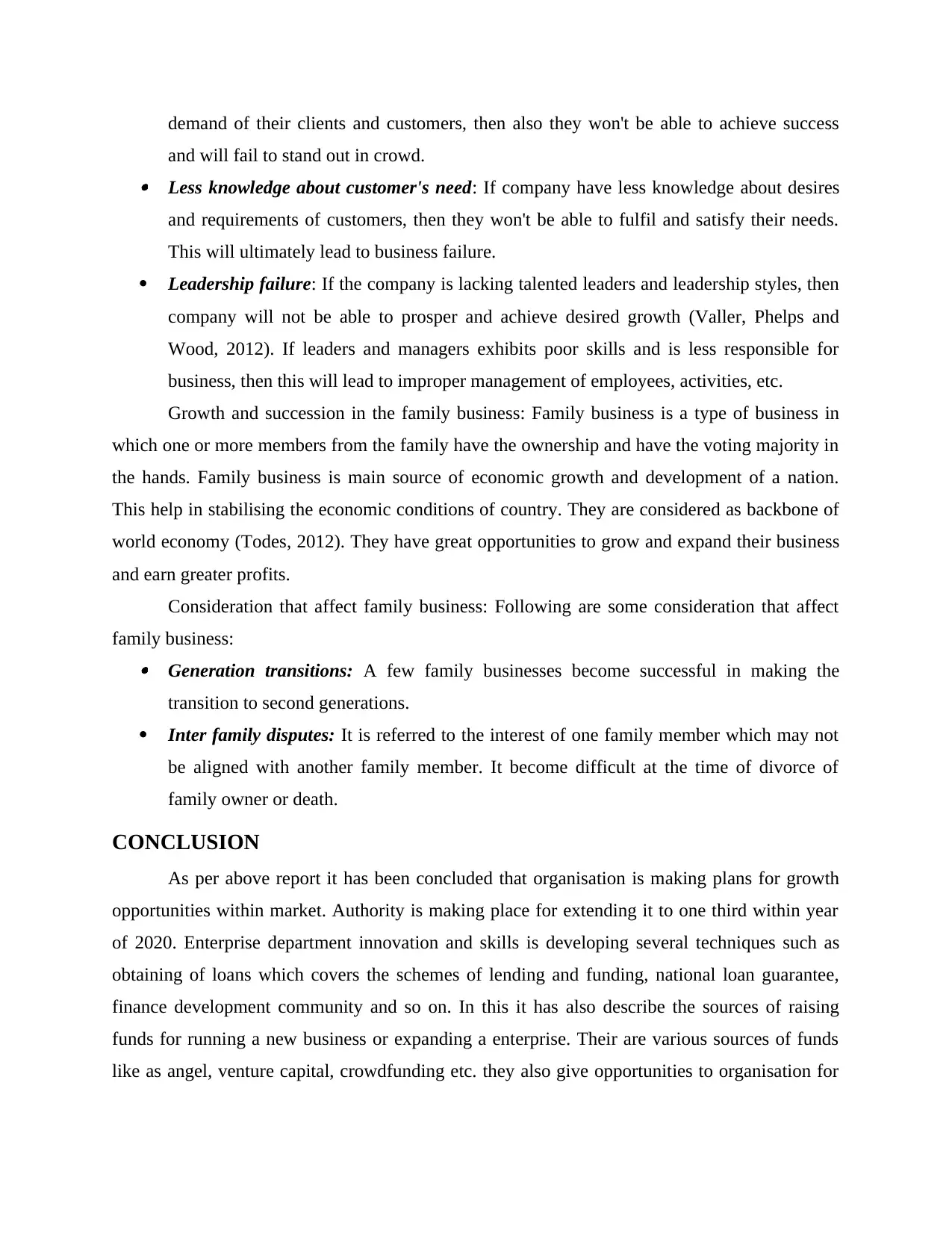
demand of their clients and customers, then also they won't be able to achieve success
and will fail to stand out in crowd. Less knowledge about customer's need: If company have less knowledge about desires
and requirements of customers, then they won't be able to fulfil and satisfy their needs.
This will ultimately lead to business failure.
Leadership failure: If the company is lacking talented leaders and leadership styles, then
company will not be able to prosper and achieve desired growth (Valler, Phelps and
Wood, 2012). If leaders and managers exhibits poor skills and is less responsible for
business, then this will lead to improper management of employees, activities, etc.
Growth and succession in the family business: Family business is a type of business in
which one or more members from the family have the ownership and have the voting majority in
the hands. Family business is main source of economic growth and development of a nation.
This help in stabilising the economic conditions of country. They are considered as backbone of
world economy (Todes, 2012). They have great opportunities to grow and expand their business
and earn greater profits.
Consideration that affect family business: Following are some consideration that affect
family business: Generation transitions: A few family businesses become successful in making the
transition to second generations.
Inter family disputes: It is referred to the interest of one family member which may not
be aligned with another family member. It become difficult at the time of divorce of
family owner or death.
CONCLUSION
As per above report it has been concluded that organisation is making plans for growth
opportunities within market. Authority is making place for extending it to one third within year
of 2020. Enterprise department innovation and skills is developing several techniques such as
obtaining of loans which covers the schemes of lending and funding, national loan guarantee,
finance development community and so on. In this it has also describe the sources of raising
funds for running a new business or expanding a enterprise. Their are various sources of funds
like as angel, venture capital, crowdfunding etc. they also give opportunities to organisation for
and will fail to stand out in crowd. Less knowledge about customer's need: If company have less knowledge about desires
and requirements of customers, then they won't be able to fulfil and satisfy their needs.
This will ultimately lead to business failure.
Leadership failure: If the company is lacking talented leaders and leadership styles, then
company will not be able to prosper and achieve desired growth (Valler, Phelps and
Wood, 2012). If leaders and managers exhibits poor skills and is less responsible for
business, then this will lead to improper management of employees, activities, etc.
Growth and succession in the family business: Family business is a type of business in
which one or more members from the family have the ownership and have the voting majority in
the hands. Family business is main source of economic growth and development of a nation.
This help in stabilising the economic conditions of country. They are considered as backbone of
world economy (Todes, 2012). They have great opportunities to grow and expand their business
and earn greater profits.
Consideration that affect family business: Following are some consideration that affect
family business: Generation transitions: A few family businesses become successful in making the
transition to second generations.
Inter family disputes: It is referred to the interest of one family member which may not
be aligned with another family member. It become difficult at the time of divorce of
family owner or death.
CONCLUSION
As per above report it has been concluded that organisation is making plans for growth
opportunities within market. Authority is making place for extending it to one third within year
of 2020. Enterprise department innovation and skills is developing several techniques such as
obtaining of loans which covers the schemes of lending and funding, national loan guarantee,
finance development community and so on. In this it has also describe the sources of raising
funds for running a new business or expanding a enterprise. Their are various sources of funds
like as angel, venture capital, crowdfunding etc. they also give opportunities to organisation for
Secure Best Marks with AI Grader
Need help grading? Try our AI Grader for instant feedback on your assignments.

meeting a long run development of the company. They also make a plan of business for their
growth by strategic and financial objectives.
growth by strategic and financial objectives.
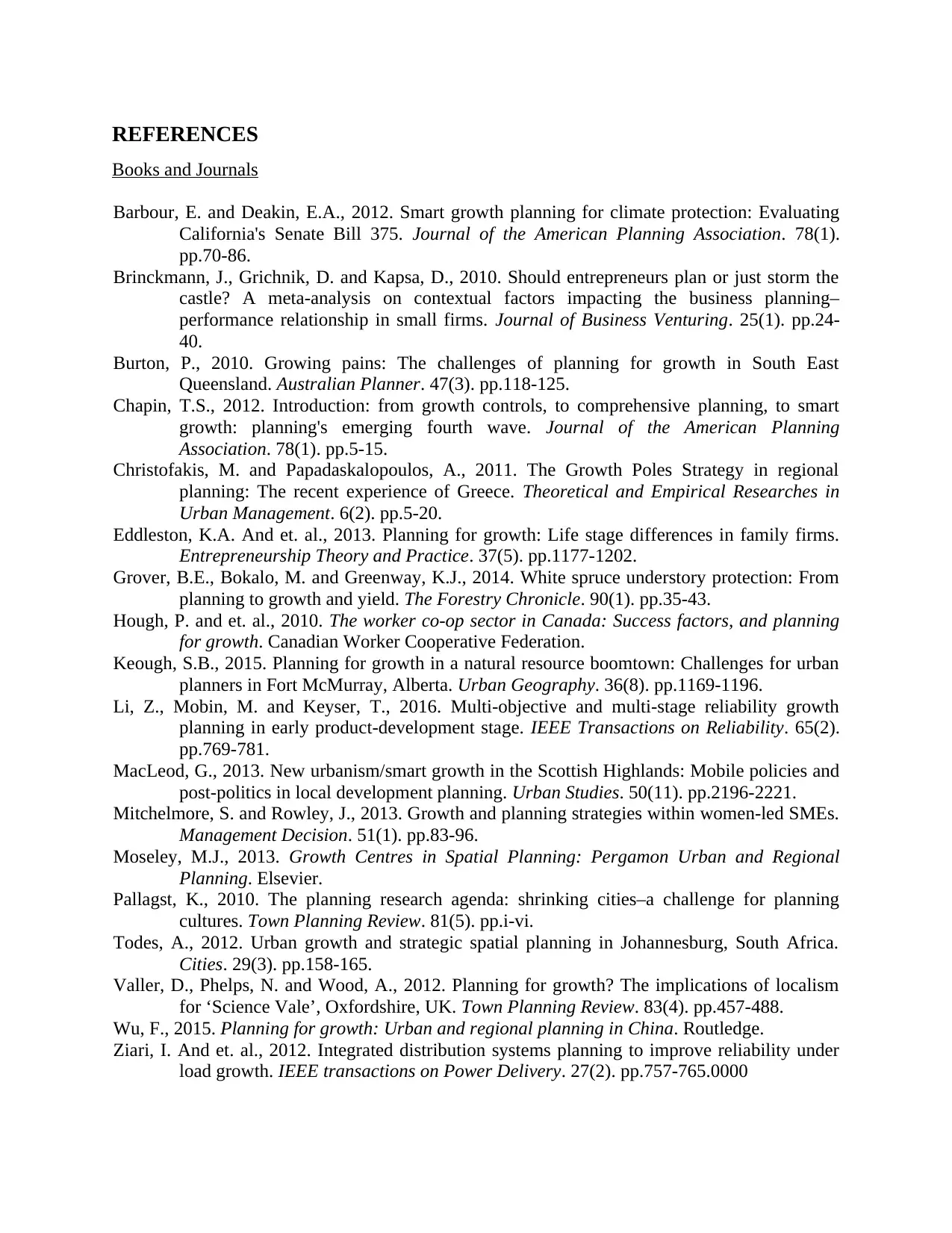
REFERENCES
Books and Journals
Barbour, E. and Deakin, E.A., 2012. Smart growth planning for climate protection: Evaluating
California's Senate Bill 375. Journal of the American Planning Association. 78(1).
pp.70-86.
Brinckmann, J., Grichnik, D. and Kapsa, D., 2010. Should entrepreneurs plan or just storm the
castle? A meta-analysis on contextual factors impacting the business planning–
performance relationship in small firms. Journal of Business Venturing. 25(1). pp.24-
40.
Burton, P., 2010. Growing pains: The challenges of planning for growth in South East
Queensland. Australian Planner. 47(3). pp.118-125.
Chapin, T.S., 2012. Introduction: from growth controls, to comprehensive planning, to smart
growth: planning's emerging fourth wave. Journal of the American Planning
Association. 78(1). pp.5-15.
Christofakis, M. and Papadaskalopoulos, A., 2011. The Growth Poles Strategy in regional
planning: The recent experience of Greece. Theoretical and Empirical Researches in
Urban Management. 6(2). pp.5-20.
Eddleston, K.A. And et. al., 2013. Planning for growth: Life stage differences in family firms.
Entrepreneurship Theory and Practice. 37(5). pp.1177-1202.
Grover, B.E., Bokalo, M. and Greenway, K.J., 2014. White spruce understory protection: From
planning to growth and yield. The Forestry Chronicle. 90(1). pp.35-43.
Hough, P. and et. al., 2010. The worker co-op sector in Canada: Success factors, and planning
for growth. Canadian Worker Cooperative Federation.
Keough, S.B., 2015. Planning for growth in a natural resource boomtown: Challenges for urban
planners in Fort McMurray, Alberta. Urban Geography. 36(8). pp.1169-1196.
Li, Z., Mobin, M. and Keyser, T., 2016. Multi-objective and multi-stage reliability growth
planning in early product-development stage. IEEE Transactions on Reliability. 65(2).
pp.769-781.
MacLeod, G., 2013. New urbanism/smart growth in the Scottish Highlands: Mobile policies and
post-politics in local development planning. Urban Studies. 50(11). pp.2196-2221.
Mitchelmore, S. and Rowley, J., 2013. Growth and planning strategies within women-led SMEs.
Management Decision. 51(1). pp.83-96.
Moseley, M.J., 2013. Growth Centres in Spatial Planning: Pergamon Urban and Regional
Planning. Elsevier.
Pallagst, K., 2010. The planning research agenda: shrinking cities–a challenge for planning
cultures. Town Planning Review. 81(5). pp.i-vi.
Todes, A., 2012. Urban growth and strategic spatial planning in Johannesburg, South Africa.
Cities. 29(3). pp.158-165.
Valler, D., Phelps, N. and Wood, A., 2012. Planning for growth? The implications of localism
for ‘Science Vale’, Oxfordshire, UK. Town Planning Review. 83(4). pp.457-488.
Wu, F., 2015. Planning for growth: Urban and regional planning in China. Routledge.
Ziari, I. And et. al., 2012. Integrated distribution systems planning to improve reliability under
load growth. IEEE transactions on Power Delivery. 27(2). pp.757-765.0000
Books and Journals
Barbour, E. and Deakin, E.A., 2012. Smart growth planning for climate protection: Evaluating
California's Senate Bill 375. Journal of the American Planning Association. 78(1).
pp.70-86.
Brinckmann, J., Grichnik, D. and Kapsa, D., 2010. Should entrepreneurs plan or just storm the
castle? A meta-analysis on contextual factors impacting the business planning–
performance relationship in small firms. Journal of Business Venturing. 25(1). pp.24-
40.
Burton, P., 2010. Growing pains: The challenges of planning for growth in South East
Queensland. Australian Planner. 47(3). pp.118-125.
Chapin, T.S., 2012. Introduction: from growth controls, to comprehensive planning, to smart
growth: planning's emerging fourth wave. Journal of the American Planning
Association. 78(1). pp.5-15.
Christofakis, M. and Papadaskalopoulos, A., 2011. The Growth Poles Strategy in regional
planning: The recent experience of Greece. Theoretical and Empirical Researches in
Urban Management. 6(2). pp.5-20.
Eddleston, K.A. And et. al., 2013. Planning for growth: Life stage differences in family firms.
Entrepreneurship Theory and Practice. 37(5). pp.1177-1202.
Grover, B.E., Bokalo, M. and Greenway, K.J., 2014. White spruce understory protection: From
planning to growth and yield. The Forestry Chronicle. 90(1). pp.35-43.
Hough, P. and et. al., 2010. The worker co-op sector in Canada: Success factors, and planning
for growth. Canadian Worker Cooperative Federation.
Keough, S.B., 2015. Planning for growth in a natural resource boomtown: Challenges for urban
planners in Fort McMurray, Alberta. Urban Geography. 36(8). pp.1169-1196.
Li, Z., Mobin, M. and Keyser, T., 2016. Multi-objective and multi-stage reliability growth
planning in early product-development stage. IEEE Transactions on Reliability. 65(2).
pp.769-781.
MacLeod, G., 2013. New urbanism/smart growth in the Scottish Highlands: Mobile policies and
post-politics in local development planning. Urban Studies. 50(11). pp.2196-2221.
Mitchelmore, S. and Rowley, J., 2013. Growth and planning strategies within women-led SMEs.
Management Decision. 51(1). pp.83-96.
Moseley, M.J., 2013. Growth Centres in Spatial Planning: Pergamon Urban and Regional
Planning. Elsevier.
Pallagst, K., 2010. The planning research agenda: shrinking cities–a challenge for planning
cultures. Town Planning Review. 81(5). pp.i-vi.
Todes, A., 2012. Urban growth and strategic spatial planning in Johannesburg, South Africa.
Cities. 29(3). pp.158-165.
Valler, D., Phelps, N. and Wood, A., 2012. Planning for growth? The implications of localism
for ‘Science Vale’, Oxfordshire, UK. Town Planning Review. 83(4). pp.457-488.
Wu, F., 2015. Planning for growth: Urban and regional planning in China. Routledge.
Ziari, I. And et. al., 2012. Integrated distribution systems planning to improve reliability under
load growth. IEEE transactions on Power Delivery. 27(2). pp.757-765.0000
1 out of 18
Related Documents
Your All-in-One AI-Powered Toolkit for Academic Success.
+13062052269
info@desklib.com
Available 24*7 on WhatsApp / Email
![[object Object]](/_next/static/media/star-bottom.7253800d.svg)
Unlock your academic potential
© 2024 | Zucol Services PVT LTD | All rights reserved.





